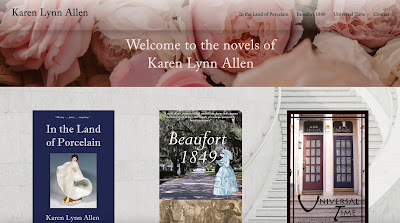Karen Lynn Allen's Blog
April 20, 2025
Beaufort 1849 available as Audiobook
Audible has created AI book narration that has been adapted for Beaufort 1849. While it's not as good as a human who can do voices for each character, it's much better than I thought it would be. If you like audiobooks, give it a try! And if you do, let me know what you think in the comments.
May 25, 2024
Author Website Refresh
May 9, 2024
Nine Life Lessons from Marathon Training as an Older Runner
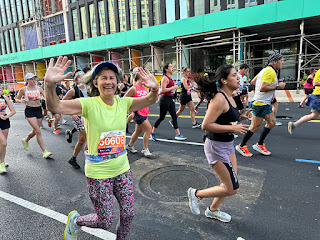
When I was seventeen,I ran the Seattle Marathon following my senior year of cross-country. Ifigured I was in the best shape of my life and this was the time to give amarathon a try. I then largely retired from running, just occasionally trottinga few miles to keep in some kind of shape. In 2018 and 2019 when I saw coverageof the New York City Marathon that goes through all five boroughs, I thought “thatlooks so cool,” but being in my late fifties, I put it down as out of thequestion. In 2020 the NYC marathon was cancelled due to COVID. When it ranagain in 2021, something in me said, “I want to do that.” My son lived inManhattan, I’d been there many times and also visited Brooklyn and the Bronx,but I’d never stepped foot in Queens or Staten Island. And all the crowds andenergy of the event—something called.
Gettinginto the race was complex as I didn’t get selected in the lottery for the 2022race but instead got a slot for the 2023 race if I ran a marathon in Novemberof 2022 anywhere of my choosing. So I trained and trained, designed and ran myown marathon as directed, and then ran the New York City marathon in 2023. Andthen my daughter talked me into running the Colorado Marathon a week ago. Withfour lifetime marathons under my belt, I am now done. But the wisdom I gainedis applicable to many things.
1. Attitude matters. On training runs, gettingout the door is half the battle, but if you go out with the attitude, “this isawful, why am I doing it, I feel terrible, etc.” you will be miserable. If yougo out with the attitude “I get to run today! Once I get going, I’m going tofeel great,” you’ll have a much better experience. Even better if you can smileand nod at people rather than grimace and show suffering. You may scoff, but transmittingwell-being and positive vibes in your neighborhood has a ripple effect. You willcover many miles as you run. You can be a force for grouchiness or a force for cheeriness,your choice.
2. Know your why. This may seem obvious, butwhy are you running? What do you hope to get out of it? A slimmer body? Afeeling of mastery? Bragging rights? Stress release? Maybe you want to improvebone density, lower your blood pressure, stave off diabetes, and increase thelikelihood of a long, healthy life. Because someone else thinks you should is avery weak why. Because other people might admire you is another whythat will fade when the going gets tough. If you’re clear on your why, alot of other stuff falls into place.
3. Don’t compare yourself to others. When Istarted training, most runners were faster than me. Some were way faster.Gradually I improved until some runners were slower than me. But getting caughtup in comparisons is a bad mental trap. The person sprinting by me might onlyhave time for a 2-mile workout while I’m out on a 10-mile run. Someone goingslowly might be on a recovery run or doing low-heartrate training. Anothermight’ve just finished with chemotherapy and it’s their first time back intheir running shoes. You just don’t know. It doesn’t matter. Everyone is outgetting exercise in the fresh air, and it’s wonderful whatever their pace.
4. The natural world matters. I’m not a fanof running in heat or in the rain, but it takes many months to train for a marathon,so you’re bound to hit unpleasant weather now and again. Train anyway. Altitudematters. The elevation of the Colorado Marathon that started at 6500 feetkicked my butt because I’d trained almost entirely at sea level. So it goes.Air quality matters. During the fires in California a couple years back the airwas so bad I couldn’t leave the house. I got a treadmill that I will use underduress, but breathable air is fundamental to existence, and I’m not sure why wedon’t all take it more seriously. The most important thing about the naturalworld is that it’s wonderful! I live in San Francisco, and it’s 1.5 miles frommy front door to the Panhandle. On the way I have to deal with traffic, unevensidewalks, and stoplights. But once I get to the path that winds through 100-year-oldtrees, life is good. A couple more stoplights and I’m in Golden Gate Park whereI can run miles surrounded by flora and fauna and shade and birdsong and nocars. (Numerous public bathrooms are a big plus.) Being out in nature issoothing and energizing and a reward in and of itself. Everyone should haveaccess to large stretches of nature. It should be a basic human right.
5. What you ingest matters. Your body ismade up of what you feed it. Things that are toxic really do affect it. Graduallyover the years I’ve shed many things from my diet: high fructose corn syrup,corporate fast food, corporate highly processed carbs, alcohol, most sugar, and,recently, seed oils. What’s left to eat, you might ask? All sorts of delicious thingsthat don’t have to cost that much or take long to prepare. YMMV, but I eatdairy, vegetables, some meat, some complex carbs, and I drink a lot of tea. I also occasionally indulge instreet tacos and bread from small bakeries. When I upped my mileage, I upped myprotein intake with more eggs per week. I did have to add a banana in the mornings before long runs. Eating this way mybody feels great. My inflammation levels are low, and my energy levels arehigh. I take some supplements, but no medications. If you’re strong, young, andfit, you can probably get by with some toxicity now and again, but theolder you get, the more this stuff matters. The other thing I’ll point out isthat since muscle weighs more than fat, when you start to get in shape you’lllikely lose inches more quickly than weight, but that’s okay, because your waistline is far more important to your health anyway.
6. Honor who you are, your body, and yourlimits. I like running alone at my own pace, listening to my music, beingwith my thoughts. My daughter really likes running with other people. Neitheris better or worse; our preferences are intrinsic to who we are. Silly not toknow how you’re wired and honor that. Same with your body. If you listen to it,it’ll tell you all sorts of things, but since most of us are disconnected fromour bodies, it can take a while to learn the language. My tai chi teacher oncesaid, “There's the pain of injury and the pain of change. Learn to know thedifference.” I would add that there is pain to ignore and pain to pay attentionto. Pretty much every runner will tell you the first mile never feels good. Duringthat mile I often get fleeting pain in my knees, hips or muscles. 99% of thetime these things go away. When pain is stabbing or doesn’t go away, it’s timeto pay attention, maybe even stop. If you train incrementally and onlygradually increase miles/intensity, this kind of pain is less likely to occur.But when it does, you have to deal with it, even if it means you have to take aweek or two off. Appreciate your body; thank it. It’s a wonderful gift, ahighly advanced piece of biochemical machinery that’s yours for life. Never derideit or shame it. It hears what you say. Lastly, limits. As you get in shape,your limits will expand, but they will still be there. If you’re over 40 andnot Kenyan, you are unlikely to ever win a major marathon. That’s okay. Knowyour why. I started training for the NYC marathon to challenge my bodyand have a certain experience. Though I would’ve liked to have run a BostonMarathon qualifying time for my age group, I never quite managed it. If I’dtrained 50 miles a week instead of 40, maybe I could’ve achieved it, but I hadmy limits. And the Boston Marathon was never my why. I achieved my whyand I’m satisfied.
7. Good tech can help. When I was in highschool, I was thrilled to have a pair of Nike trainers with waffle bottoms. Theother “tech” assistance I had was heavy cotton sweats, t-shirts, and water from drinking fountains. I seriously didn’t even own a water bottle. Now I have afitness watch, headphones, a great running playlist, a cheststrap for low-heartratetraining, gels, a hydration backpack, lycra leggings, great shoes with inserts,good sports bras, a waistpack, a variety of running shirts suited to differentconditions, sunglasses, visors, and four different kinds of electrolyte mixes Ilike. Whew! All this stuff does help (especially the music.) But in the end,you still have to run the miles.
8. Small increments are powerful. Trainingfor a marathon is a long road. I started out running 9 miles a week and over thecourse of 6 months worked up to 40 miles a week. With enough time, dedication,and small increments, you can do things you might not believe possible.Increments are important in other ways. We create our bodies and our lives onebite, one step, and one thought at a time. Yes, a doughnut here, a grouchy thoughtthere, or even a skipped training run is not going to make much difference. Buta pattern of them sure will. It’s the pattern that counts. The good news isthat in every moment you can start afresh. Your point of power is now, goingforward. One step, one bite, one thought at a time.
9. Find the joy. This was a tip from anultra-marathoner. A good attitude and knowing your why are important,but there’s even a deeper level to obtain. If running makes you miserable, don’tdo it: find some other way to achieve your why. But even being so-soabout your training is a waste of time because, like almost everything, if youdig deep enough, there is joy to be found in tackling a marathon. It may befrom your body when you can stride along without gasping for air. It may befrom birdsong in the morning hours, the aromatic fresh air, or the sunset thatcloses down the evening. It may be from waving at a small child on your run orgreeting a tree friend. Whatever it is, find it. We are all responsible for ourown joy. No one can give it to you. But it will be there if you seek it. Find the joy.
@font-face {font-family:"Cambria Math"; panose-1:2 4 5 3 5 4 6 3 2 4; mso-font-charset:0; mso-generic-font-family:roman; mso-font-pitch:variable; mso-font-signature:-536870145 1107305727 0 0 415 0;}@font-face {font-family:Aptos; panose-1:2 11 0 4 2 2 2 2 2 4; mso-font-charset:0; mso-generic-font-family:swiss; mso-font-pitch:variable; mso-font-signature:536871559 3 0 0 415 0;}p.MsoNormal, li.MsoNormal, div.MsoNormal {mso-style-unhide:no; mso-style-qformat:yes; mso-style-parent:""; margin:0in; mso-pagination:widow-orphan; font-size:12.0pt; font-family:"Aptos",sans-serif; mso-ascii-font-family:Aptos; mso-ascii-theme-font:minor-latin; mso-fareast-font-family:Aptos; mso-fareast-theme-font:minor-latin; mso-hansi-font-family:Aptos; mso-hansi-theme-font:minor-latin; mso-bidi-font-family:"Times New Roman"; mso-bidi-theme-font:minor-bidi;}p.MsoListParagraph, li.MsoListParagraph, div.MsoListParagraph {mso-style-priority:34; mso-style-unhide:no; mso-style-qformat:yes; margin-top:0in; margin-right:0in; margin-bottom:0in; margin-left:.5in; mso-add-space:auto; mso-pagination:widow-orphan; font-size:12.0pt; font-family:"Aptos",sans-serif; mso-ascii-font-family:Aptos; mso-ascii-theme-font:minor-latin; mso-fareast-font-family:Aptos; mso-fareast-theme-font:minor-latin; mso-hansi-font-family:Aptos; mso-hansi-theme-font:minor-latin; mso-bidi-font-family:"Times New Roman"; mso-bidi-theme-font:minor-bidi;}p.MsoListParagraphCxSpFirst, li.MsoListParagraphCxSpFirst, div.MsoListParagraphCxSpFirst {mso-style-priority:34; mso-style-unhide:no; mso-style-qformat:yes; mso-style-type:export-only; margin-top:0in; margin-right:0in; margin-bottom:0in; margin-left:.5in; mso-add-space:auto; mso-pagination:widow-orphan; font-size:12.0pt; font-family:"Aptos",sans-serif; mso-ascii-font-family:Aptos; mso-ascii-theme-font:minor-latin; mso-fareast-font-family:Aptos; mso-fareast-theme-font:minor-latin; mso-hansi-font-family:Aptos; mso-hansi-theme-font:minor-latin; mso-bidi-font-family:"Times New Roman"; mso-bidi-theme-font:minor-bidi;}p.MsoListParagraphCxSpMiddle, li.MsoListParagraphCxSpMiddle, div.MsoListParagraphCxSpMiddle {mso-style-priority:34; mso-style-unhide:no; mso-style-qformat:yes; mso-style-type:export-only; margin-top:0in; margin-right:0in; margin-bottom:0in; margin-left:.5in; mso-add-space:auto; mso-pagination:widow-orphan; font-size:12.0pt; font-family:"Aptos",sans-serif; mso-ascii-font-family:Aptos; mso-ascii-theme-font:minor-latin; mso-fareast-font-family:Aptos; mso-fareast-theme-font:minor-latin; mso-hansi-font-family:Aptos; mso-hansi-theme-font:minor-latin; mso-bidi-font-family:"Times New Roman"; mso-bidi-theme-font:minor-bidi;}p.MsoListParagraphCxSpLast, li.MsoListParagraphCxSpLast, div.MsoListParagraphCxSpLast {mso-style-priority:34; mso-style-unhide:no; mso-style-qformat:yes; mso-style-type:export-only; margin-top:0in; margin-right:0in; margin-bottom:0in; margin-left:.5in; mso-add-space:auto; mso-pagination:widow-orphan; font-size:12.0pt; font-family:"Aptos",sans-serif; mso-ascii-font-family:Aptos; mso-ascii-theme-font:minor-latin; mso-fareast-font-family:Aptos; mso-fareast-theme-font:minor-latin; mso-hansi-font-family:Aptos; mso-hansi-theme-font:minor-latin; mso-bidi-font-family:"Times New Roman"; mso-bidi-theme-font:minor-bidi;}.MsoChpDefault {mso-style-type:export-only; mso-default-props:yes; mso-ascii-font-family:Aptos; mso-ascii-theme-font:minor-latin; mso-fareast-font-family:Aptos; mso-fareast-theme-font:minor-latin; mso-hansi-font-family:Aptos; mso-hansi-theme-font:minor-latin; mso-bidi-font-family:"Times New Roman"; mso-bidi-theme-font:minor-bidi; mso-font-kerning:0pt; mso-ligatures:none;}div.WordSection1 {page:WordSection1;}ol {margin-bottom:0in;}ul {margin-bottom:0in;}
December 30, 2023
In the Land of Porcelain is out! It can be purchased in p...
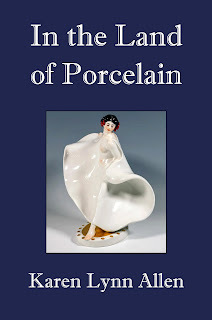
In the Land of Porcelain is out! It can be purchased in paperbook or ebook on-line, or it can ordered at any bookstore. Audiobook version coming soon!
When Sara's husband, Mark, goes to law school on the East Coast, Sara moves in with her mercurial sister because she's just gotten promoted at her job and doesn't want to leave San Francisco. It's manageable. She and Mark will both focus on their careers and temporarily be BCDR, that's all-bi-coastal, dual rental. To keep busy Sara begins City Buddha-Mind walking and volunteers at a domestic violence shelter. But after Aaron, a high-powered consultant, offers to mentor her, Sara soon realizes her life isn't as under control as she thought it was. Set in the early 1990's, In the Land of Porcelain is a young woman's roller-coaster journey to self-discovery, deeper love, and breaking free.
"Karen Allen has written a story of a woman waking up to her life, and waking up, and waking up--with help and distractions from a host of three-dimensional, fascinating characters. It's a moving book, a funny one, and even an inspiring one."--Tonya Edwards
April 17, 2021
What We Encourage
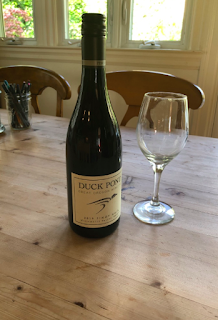 Well supported and well supplied
Well supported and well suppliedAfter forty-three years of driving, my husband and I went car-free last summer in San Francisco. There are parallels. Hang with me.
I started drinking alcohol in college at age eighteen. This was relatively late for my generation. As with most people, I saw alcohol as a mark of adulthood, good for socializing, relaxing, and easing stress.
I knew alcohol was prevalent in American culture, but once I went off it, how much reinforcement there is for drinking really slapped me in the face. It is inhospitable for a host/hostess not to offer their guests alcohol. Period. In restaurants waiters are visibly disappointed that your dinner bill will not include $25 for two glasses of wine. Friends suggest bars as a natural place to meet up in the evening. Within half a mile of my house there are two grocery stores, three corner stores, and four liquor stores that, combined, offer far more shelving feet of alcohol for sale than nutritious food. (Don’t get me started on the food deserts of impoverished neighborhoods.) Bottles of alcohol are on maximum view in every bar and restaurant (are that evening’s vegetables so elegantly displayed?) and pre-Covid, the quantity of alcohol consumed before, during, and after plane flights was frankly astounding. Remember all the chuckles and cute memes about quarantine drinking? Binge drinking went through the roof this past year, especially among women.
In TV and movies the characters show they’re having a good time by drinking. Alcohol ads oriented towards women paint pictures of intimacy, romance, and friendship. Alcohol ads promise men status, friendship, and sex. In social media, friends and family take selfies with their drinks to prove they’re having a good time. Our culture is saturated in alcohol, and if you don’t believe it, go off alcohol for a month and see how many times you are invited, encouraged, reminded, or pushed to have a drink. Even more annoying, some people may assume you have a psychological disorder since “normal” people choose to drink. And then you’ll hear at length why drinking is fine for them since they have no problem with alcohol. (Since I’ve done this to other people, it’s likely fitting that I’m now on the receiving end.)
And our society is largely unconscious of all of this.
And yet. And yet alcohol is toxic to the human body. Small doses are a little toxic; large doses are very toxic.
And it’s possible to feel good without alcohol. In fact, it’s possible to feel great without alcohol and to feel so far more consistently. Indeed, some schools of thought view alcohol as an impediment to one’s spiritual progression.
One of the biggest reasons I went off alcohol was middle-of-the-night insomnia. I was already meditating and exercising daily but still I would wake up at 2 am. Six months later, my sleep has vastly improved, but even better has been the benefits to my spiritual journey. I feel more connected to nature; I feel more connected to grace. I’m more conscious now of when I’m choosing between love and fear and I now more often manage to opt for love. Maybe this self-acceptance and heart-opening would’ve happened anyway, I can’t say for sure. I mention this knowing that many will have no idea what I’m talking about. That’s okay. The path is a breadcrumb trail, and those inclined to follow it will.
Still, I’m very conscious that by not drinking I’ve put myself outside normal human experience. And I’m still working to accept that people are puzzled and even disturbed by my choice, even as I used to be when I ran across someone who didn’t drink.
Onward.
I was thrilled to get my driver’s license at age sixteen. It’s one of the most profound rites of passage we have for teenagers. A license means independence, power, and status! A heady brew indeed. Even though my family of six scraped along with just one car, and I had to wheedle my parents for every minute of driving I got, since I lived in a suburb with no public transit and no safe biking, that license significantly changed my life.
And so over the years I drove and drove and drove, even after moving to a city. Road trips, daily commute trips, and transporting children trips. (Trips to the orthodontist were nearly endless.) I saw cars as convenient, safe, and necessary because even though I lived in one of the densest places in North America, my way of life was still designed around a car. In fact, I chose my children’s schools partly based on how easily I could drive there and park.
Before we went car-free, my husband and I spent a few years seeing how little we could drive as a kind of hobby. We’d long been bicyclists, but after we both got electric bikes it became faster to get almost anywhere in the city by bike instead of car. When we traveled, we tried not to rent a car but instead took rail or light rail, a Lyft ride or two, and did a lot of walking.
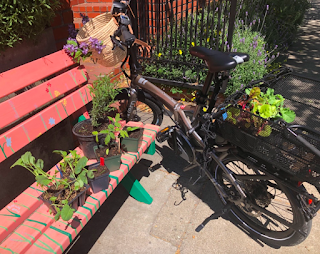 Plant shopping by bike
Plant shopping by bikeI’ve found that not driving has embedded more exercise in my daily life. It’s made me more connected to the nature around me, even in my urban neighborhood. (There are trees! Birds! Flowers! Stars! The Moon!) I’ve also discovered that not driving has improved my character. I’m less impatient, less aggressive, and less hostile as I travel. I’m more likely to see my fellow human beings on the street as equals rather than obstacles. Whether on foot, public transit or my bicycle, I’m not both powerful and anonymous like I am in a car. (Power and anonymity are not a good combination for the human psyche.) There’s more mutuality, more sense of sharing the street space rather than pushing through and dominating it. Though San Francisco has considerable problems with drug addiction, homelessness and encampments, when I walk or bike I generally only feel threatened by the actions of drivers encased in thousands of pounds of metal.
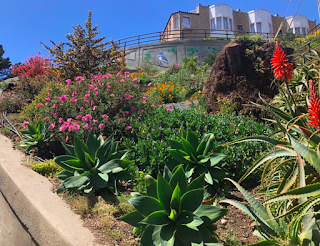 New local garden
New local gardenCar driving is reinforced in our society every which way we look. Literally. The basic design of our neighborhoods, our streets, and our cities is created to accommodate cars. In San Francisco a quarter of all land is dedicated to car driving or parking. Just like alcohol, cars are constantly sold to us. Women are told a car means safety, convenience, and status while men are promised sex, domination, and status. I rarely watch commercial tv, but my husband is a fan of sports. When I sit down with him in front of a football game I feel absolutely bombarded by car and beer ads. These ads aren’t random: they work. Indeed, one fourth of the cost of a new car is the cost of marketing and advertising. (Thought experiment: if car and beer advertising went away tomorrow, would there be any professional sports left?)
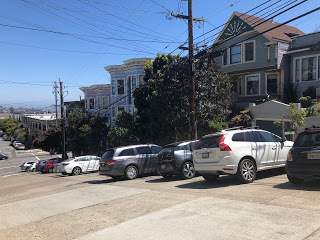 Best use of space?
Best use of space?Our culture is saturated in cars. Parking lots dominate our public spaces, and children spend more time strapped into carseats than in active play. The only place you can get away from cars are public parks/beaches/forests that offer good hikes. If you don’t believe me, try going car-free for a month. Impossible, you say! You live miles from where you work and shop. (Or, what I hear most often, you’d get killed by one of the crazy drivers on the road.) Exactly, I say. Our entire way of life, from the ground up, is designed to make Americans utterly dependent on their vehicles. And our society is largely unconscious of this.
Does drinking alcohol make you a bad person? No. Does driving a car make you evil? Of course not. Everyone is on their own path, has their own individual circumstances, and deserves to enjoy their life. Not drinking won’t automatically solve all your problems, and not driving won’t turn your community into Shangri-La anytime soon. But I suggest that there are very good reasons not to drink alcohol as well as not to drive a car before even taking into account alcoholism, drunk driving, peak oil, and climate change. I’ll also point out that while one set of choices is promoted, reinforced, and made as convenient as possible, the other set is shamed, challenged, or made as dangerous as possible. It would be nice if our society created a little more physical and psychological space for those who choose the path less taken.
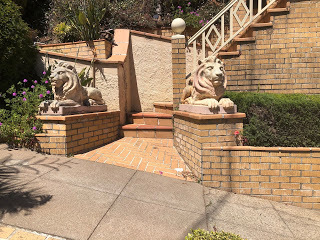 Neighborhood guardians that inspire love, not fear
Neighborhood guardians that inspire love, not fear(Photo credits: all photos taken by Karen Allen)
@font-face {font-family:"MS 明朝"; panose-1:0 0 0 0 0 0 0 0 0 0; mso-font-charset:128; mso-generic-font-family:roman; mso-font-format:other; mso-font-pitch:fixed; mso-font-signature:1 134676480 16 0 131072 0;}@font-face {font-family:"MS 明朝"; panose-1:0 0 0 0 0 0 0 0 0 0; mso-font-charset:128; mso-generic-font-family:roman; mso-font-format:other; mso-font-pitch:fixed; mso-font-signature:1 134676480 16 0 131072 0;}@font-face {font-family:Cambria; panose-1:2 4 5 3 5 4 6 3 2 4; mso-font-charset:0; mso-generic-font-family:auto; mso-font-pitch:variable; mso-font-signature:-536870145 1073743103 0 0 415 0;}p.MsoNormal, li.MsoNormal, div.MsoNormal {mso-style-unhide:no; mso-style-qformat:yes; mso-style-parent:""; margin:0in; margin-bottom:.0001pt; mso-pagination:widow-orphan; font-size:12.0pt; font-family:Cambria; mso-ascii-font-family:Cambria; mso-ascii-theme-font:minor-latin; mso-fareast-font-family:"MS 明朝"; mso-fareast-theme-font:minor-fareast; mso-hansi-font-family:Cambria; mso-hansi-theme-font:minor-latin; mso-bidi-font-family:"Times New Roman"; mso-bidi-theme-font:minor-bidi;}.MsoChpDefault {mso-style-type:export-only; mso-default-props:yes; font-family:Cambria; mso-ascii-font-family:Cambria; mso-ascii-theme-font:minor-latin; mso-fareast-font-family:"MS 明朝"; mso-fareast-theme-font:minor-fareast; mso-hansi-font-family:Cambria; mso-hansi-theme-font:minor-latin; mso-bidi-font-family:"Times New Roman"; mso-bidi-theme-font:minor-bidi;}div.WordSection1 {page:WordSection1;}
November 30, 2020
Put Down Those Rocks You're Carrying
 Imagine that as a child you were issued a large backpack to wear at all times. At first you didn’t know what it was for, but then the adults around you started putting rocks in it that you then obediently carried around. After a while you followed their example and began to put rocks in there yourself. Over time, some of the rocks disappeared, but most didn’t, and by now that pack’s really, really heavy.
Imagine that as a child you were issued a large backpack to wear at all times. At first you didn’t know what it was for, but then the adults around you started putting rocks in it that you then obediently carried around. After a while you followed their example and began to put rocks in there yourself. Over time, some of the rocks disappeared, but most didn’t, and by now that pack’s really, really heavy.You often pull out some of the rocks and look at them. They don’t make you happy. In fact they make you miserable. Some at the bottom you never pull out—you might not even remember you have them--but still you carry them. This seems inexplicable. Why would anyone voluntarily bear such a burden?
Unfortunately these rocks are not chunks of shale or granite or sandstone. Those would be easy to get rid of! Instead they are bits of residual resentment, hatred, anger, guilt, and shame from injuries or injustices or mistakes you can’t or won’t or haven’t tried to let go of. The backpack is your mind; the weight of the load burdens not your back but your soul.
What follows are tips for cleaning out that backpack. If the pack’s stuffed full, it’ll take some mental elbow grease to do a good spring cleaning, but trust me, it’s worth it for the sunlight that will pour into your life. After that, there’ll be some ongoing maintenance to keep your pack light and your steps jaunty. Yes, there’ll be surprises. Rocks that you’ll swear you never picked up will somehow get in that backpack, and a few rocks will keep reappearing even after you put them down and down again. Still the effort’s worth it.
So how to get rid of these rocks? The first step is to realize that anger, hatred, resentment, guilt, and shame are not just weight, they’re toxic, poisonous to a healthy life. They cloud your judgement; they sap your attention and energy. They lead to bitterness, depression and despair. If you feed these toxic emotions, the rocks will grow until they’re all you have left. At its most basic, carrying around these rocks is a form of self-harm.
Instead when these emotions arise, acknowledge them, learn from them. Take action if appropriate. And then let them go. This doesn’t mean you should allow people who’ve injured you to do so again. But caution, wisdom, and courage prevent injury better than anger and resentment.
Back to spring cleaning. All of us have childhoods that involved rocks. Some of us had really bad childhoods with backpacks that are overflowing. I’m so sorry. Our families and our society should treat children so much better. But if you’re reading this, you’re likely an adult with a lot more control over your life now. Carrying a heavy psychic backpack helps nothing.
The first rocks to get rid of are those pertaining to parents. You can forgive or not forgive, but either way the weight’s killing you. You have to let go. One way to do this is to imagine your five-year-old self. What do you need? What do you wish you’d gotten? More love? What would that look like—more hugs, more safety, someone to read to you at bedtime, someone to tell you you’re wonderful? Whatever it is, imagine your adult self taking your child self by the hand and giving them whatever they didn’t get. Yes, this doesn’t seem rational, but the inner child in you isn’t rational, just needy. Re-parent yourself. Take five minutes here, five minutes there and imagine giving that five-year-old what he or she needs.
 It's big. It can take it.
It's big. It can take it.When that five year old is calm and happy, slip him or her gently into your heart for safekeeping. (If there was another time in your life when you were especially needy, say as a teenager, then do the same for that self.) With your child selves safely tucked away, imagine standing at the rim of the Grand Canyon. It’s so vast, so deep, it can absorb and neutralize all the negativity you have to give it. Then imagine dumping out your whole backpack over the edge. Not all the rocks will fall out. Many will stick. Over the course of the next month, take these stuck ones out one by one as they arise in your mind. Say, “What did I learn from this?” The answer may not come right away. Be patient. Once you hear it say, “Okay, thanks. I don’t need you any longer.” And throw that rock as far as you can. See it dissolve as it falls towards the earth. You may have to take out nasty rocks you didn’t ever want to touch again. Get the learning and toss. And if these rocks show up again, know there’s a little more learning to squeeze from them and then toss once more. If there’s abuse trauma that you don’t want to examine incident by incident, mentally put all those rocks in one bag, decide what the life lesson was from the cumulative experience. Sit with it, grieve, and then heave ho the entire sack. That there might be a life lesson doesn't imply that the abuse was in any way your fault. Far from it! The lesson may be that damaged people damage, or that you have a ferocity to survive. Whatever it is, you'll know it when it the weight lifts.
When you’ve got most of your parent rocks cleaned out, try to find one memory from each parent when they showed love, or at least kindness, towards you. Let that memory gleam, and put it in your heart. And from now on, when you think of your parents, don’t trot out all the garbage from your childhood--pull out the gleaming memories because that is what’s going to let you be at peace. It doesn’t mean rewriting history. All the crapola happened, but you let it be. Maybe you feel some sadness, but you don’t carry the toxicity around with you anymore.
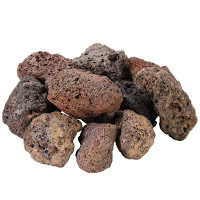 Are these yours?
Are these yours?When that’s done, you can start with your siblings, peers, and teachers. Or you can just say, “I’m going to let go of all rocks formed before 1990.” (Pick a year appropriate to your age.) I’m fifty-nine. Sometimes I’ll find a rock in my pack I didn’t realize was there. I’ll examine the date and then say, “Holy hell—am I really still carrying around something that happened forty-five years ago?” Once you hit fifty, you can let go of everything that happened before you were thirty. You were young, they were young, and you were all stupid and didn’t know better, or they were old and now likely dead. Let it go. You’ll be so glad you did.
So let’s get to guilt and shame. Those are not so much rocks as sticks that you beat yourself up with. And some of this is so deep in your subconscious you might not know what memory is triggering your suffering, only that you are bad, unworthy, don’t deserve to live, etc. This is not pleasant, but you have to pull out the mistakes you feel worst about--the ones you're most ashamed of--and say, “What should I learn from this?” Sit with the transgression and genuinely absorb what needs to be integrated. Because that’s why you still carry it with you. If you really dig into your subconscious (be warned--shame pushes things deep), you’ll likely be amazed at the fairly trivial stuff you use to convince yourself during your low moments that you’re a horrible human being. The thing is, you don’t need shame and guilt to control your behavior. Once you’ve absorbed the lesson, wisdom will keep you from repeating the mistake. No more punishment needed. You, yes you, deserve to enjoy your life.
Given how much work it is to get rid of rocks, it’s a good idea not to load up with new ones. One way to prevent new rocks is to see someone currently pushing your buttons not as your enemy but a lesson knocking at your door. This is admittedly not easy to do in the heat of the moment. But with some reflection you may realize that what you’re annoyed with in another person is a characteristic you don’t want to recognize in yourself. This applies to current political figures or even entire groups of people that have different views from you. You don’t have to stop caring about the issues important to you, you don’t have to agree with those you’re ideologically opposed to, but you have to not turn them into rocks. Which means not hating them. Which means letting go of the anger and resentment. Which means wrestling with what is the larger lesson being presented--to you personally, to your country, to humanity. What are we human beings struggling to learn? Harm is harm, so of course try to prevent or mitigate it, but hatred and anger (not to mention contempt and loathing) are not the tools.
If you can manage to get in dialogue with those you're opposed to, even better. It's true that some people are so engulfed by negativity that there's no way to communicate through it, but this not the case for the vast majority of people despite what the media might tell you. You may find some of them believe you are the source of harm. Dialogue and recognition of our common humanity is the only way to work through this. We absolutely have to start laying down our rocks and dealing with others as human beings, not as members of a group. There is much to learn from all this. Will we do it? If you're reading this article, this means you have to take the first step and put down your rocks, not wait for others to go first.
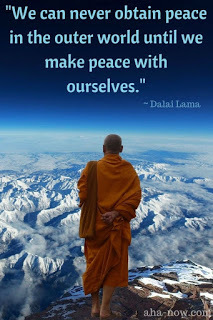
When I struggle with this advice (and I do), I think of the Dalai Lama’s response to whether he hated the Chinese for what they’d done to the Tibetan people. He responded to the effect that when you’re angry or unforgiving your mental suffering is constant. If he developed bad feelings towards the Chinese it wouldn’t solve anything, it would only destroy his own peace of mind, which would make him less capable of serving his people and humanity.
Another way to think about this is that the negative actions of any person/group are almost always symptoms of underlying problems, usually structural ones. The problems humanity faces are not due to too little anger and hatred. Indeed, our negative emotions are used to divide and exploit us, to confuse us from seeing who (or what) is behind the curtain pulling the levers. You can stop that cycle, at least with your own life and your own consciousness. If you can manage to feel compassion, empathy or even love towards those who have caused harm, more power to you. It’s a spiritual achievement that will ripple outward to benefit us all. But for now at least get rid of the negative emotions that are poisoning your soul.
Even after you get good at rock tossing and rock avoiding, now and then rocks will still get into your pack. You will get annoyed, irritated, perhaps even irate. That’s okay. Catch yourself, laugh, examine the lesson, and chuck the darn rock away. A light backpack is a joyful thing.
“You cannot solve a problem from the same consciousness that created it. You must learn to see the world anew.”—Albert Einstein
Note: If your rocks are really stubborn, a counselor or other mental health professional can assist with tossing the worst ones.
<!-- /* Font Definitions */ @font-face {font-family:"MS 明朝"; panose-1:0 0 0 0 0 0 0 0 0 0; mso-font-charset:128; mso-generic-font-family:roman; mso-font-format:other; mso-font-pitch:fixed; mso-font-signature:1 134676480 16 0 131072 0;} @font-face {font-family:"MS 明朝"; panose-1:0 0 0 0 0 0 0 0 0 0; mso-font-charset:128; mso-generic-font-family:roman; mso-font-format:other; mso-font-pitch:fixed; mso-font-signature:1 134676480 16 0 131072 0;} @font-face {font-family:Cambria; panose-1:2 4 5 3 5 4 6 3 2 4; mso-font-charset:0; mso-generic-font-family:auto; mso-font-pitch:variable; mso-font-signature:-536870145 1073743103 0 0 415 0;} /* Style Definitions */ p.MsoNormal, li.MsoNormal, div.MsoNormal {mso-style-unhide:no; mso-style-qformat:yes; mso-style-parent:""; margin:0in; margin-bottom:.0001pt; mso-pagination:widow-orphan; font-size:12.0pt; font-family:Cambria; mso-ascii-font-family:Cambria; mso-ascii-theme-font:minor-latin; mso-fareast-font-family:"MS 明朝"; mso-fareast-theme-font:minor-fareast; mso-hansi-font-family:Cambria; mso-hansi-theme-font:minor-latin; mso-bidi-font-family:"Times New Roman"; mso-bidi-theme-font:minor-bidi;} .MsoChpDefault {mso-style-type:export-only; mso-default-props:yes; font-family:Cambria; mso-ascii-font-family:Cambria; mso-ascii-theme-font:minor-latin; mso-fareast-font-family:"MS 明朝"; mso-fareast-theme-font:minor-fareast; mso-hansi-font-family:Cambria; mso-hansi-theme-font:minor-latin; mso-bidi-font-family:"Times New Roman"; mso-bidi-theme-font:minor-bidi;}size:8.5in 11.0in; margin:1.0in 1.25in 1.0in 1.25in; mso-header-margin:.5in; mso-footer-margin:.5in; mso-paper-source:0;} div.WordSection1 {page:WordSection1;}</style></p>
June 1, 2020
Social Cohesion and Public Health
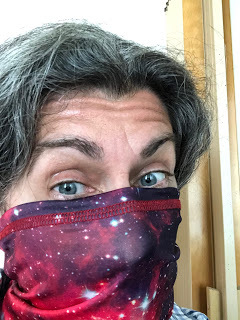 Mask: a device worn to disguise, amuse, or terrifySocial cohesion makes societies work, and once squandered, it’s difficult to rebuild. It requires trust, goodwill, and shared values, but also fairness and agreed-upon social norms. Without some level of social cohesion, groups and even society itself cannot function. Most well run countries (ones with low wealth inequality, low corruption, and high life satisfaction) have social cohesion born of a sense of trust that society works for the well-being of all its members. Though this is perhaps more difficult to achieve in racially and culturally diverse societies, Sweden and Canada have high levels of social cohesion even with 20% of Sweden's population being foreign-born and 27% of Canada's population of non-European/white background. Smart societies foster social cohesion and build social capital constantly; foolish ones fritter both away as if they have no consequence.
Mask: a device worn to disguise, amuse, or terrifySocial cohesion makes societies work, and once squandered, it’s difficult to rebuild. It requires trust, goodwill, and shared values, but also fairness and agreed-upon social norms. Without some level of social cohesion, groups and even society itself cannot function. Most well run countries (ones with low wealth inequality, low corruption, and high life satisfaction) have social cohesion born of a sense of trust that society works for the well-being of all its members. Though this is perhaps more difficult to achieve in racially and culturally diverse societies, Sweden and Canada have high levels of social cohesion even with 20% of Sweden's population being foreign-born and 27% of Canada's population of non-European/white background. Smart societies foster social cohesion and build social capital constantly; foolish ones fritter both away as if they have no consequence. There's a dark side to social cohesion, especially if it devolves into rigid conformity. The Nazis created social cohesion by vilifying Jews and promulgating their thesis that Germans were the master race. But let’s look at the flip side. In societies with little or no social cohesion, fear, distrust, corruption, and animosity rule. For decades now, American social cohesion has been falling, directly correlated, in my view, to our burgeoning wealth inequality. As a result, we don’t have a lot to fall back on now when we need it.
Right now much of the world faces a public health crisis with COVID-19. So far this disease has killed over 100,000 people in the United States and will likely kill another 100,000 in the next 100 days. This disease is largely fatal only to people who already have an underlying illness. Looking at the NYC data, it’s worth noting that even for those over sixty-five, most of those that died had one or more co-morbidity factors. The most common co-morbidities are heart disease, diabetes, hypertension, chronic respiratory disease, cancer, and obesity.
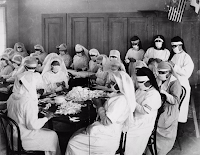 Flu ExpertsThe US hasn’t had a pandemic this deadly since 1918. We are unprepared, inexperienced, and learning how to deal with it on the fly. In order to combat this pandemic, local officials have resorted to the blunt tools of physical distancing, voluntary quarantining, mass stay-at-home orders, the closing of all but essential services, and mandatory use of masks. (There’s finally widespread testing available, and talk of contact tracing, although from what I can tell, very little of this has happened.) I live in San Francisco, the first city to impose many of these restrictions before a single case of COVID-19 was discovered. Because of the initial promptness and a high level of compliance, both the case and death count here has been remarkably low. Now, although much of the country has opened up with far higher continued case and death rates, pandemic measures continue here and mask use has gotten even stricter.
Flu ExpertsThe US hasn’t had a pandemic this deadly since 1918. We are unprepared, inexperienced, and learning how to deal with it on the fly. In order to combat this pandemic, local officials have resorted to the blunt tools of physical distancing, voluntary quarantining, mass stay-at-home orders, the closing of all but essential services, and mandatory use of masks. (There’s finally widespread testing available, and talk of contact tracing, although from what I can tell, very little of this has happened.) I live in San Francisco, the first city to impose many of these restrictions before a single case of COVID-19 was discovered. Because of the initial promptness and a high level of compliance, both the case and death count here has been remarkably low. Now, although much of the country has opened up with far higher continued case and death rates, pandemic measures continue here and mask use has gotten even stricter.I would posit that these public health measures prevent deaths but also cause them. I also believe we should be talking about loss of life-years. As painful as it may be to consider, the death by COVID-19 of someone 95 years old with kidney and heart disease might mean the loss of one life-year. The death by suicide of a 35 year old with depression worsened by social isolation might mean the loss of 50 life-years. There is a difference in magnitude that ought to be taken into account.
For public health measures to be effective, officials had to get the public’s compliance. In some countries this was literally done with soldiers challenging anyone who walked the streets. In United States, the approach was to 1) appeal to people’s compassion to prevent the disease from spreading to the vulnerable population (i.e. those with co-morbidities) and 2) make people believe they were personally at risk. As a result, the ultimate tools for fighting this epidemic have been fear and social isolation.
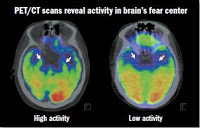 Your stressed brainFear creates stress. Stress creates emotional, psychological and physical problems, including heart disease, the number one killer in the US (648K deaths/year.)Fear also makes people do stupid things like drink bleach. Social isolation creates stress and strongly increases the risk of heart disease and stroke, the number five killer (146K deaths/year.) In fact social isolation is known to increase the risk of early death by two-thirds. It increases the risk of dementia by 40%. In a study of 20,000 Americans in 2018, 40% of adults reported being lonely. Just imagine what the number is now. And then there’s all the quarantine drinking. Cirrohsis/liver disease, the result of copious alcohol use, is US killer # 11 (42K deaths/year.) And that’s when people weren’t locked down. So while our stringent public health measures have prevented COVID deaths, we’ve also undoubtedly increased the number of future deaths due to heart disease, stroke and alcohol addiction. And let’s also remember that social isolation is profoundly bad for anyone suicidal (killer #10, 47K deaths/year.)
Your stressed brainFear creates stress. Stress creates emotional, psychological and physical problems, including heart disease, the number one killer in the US (648K deaths/year.)Fear also makes people do stupid things like drink bleach. Social isolation creates stress and strongly increases the risk of heart disease and stroke, the number five killer (146K deaths/year.) In fact social isolation is known to increase the risk of early death by two-thirds. It increases the risk of dementia by 40%. In a study of 20,000 Americans in 2018, 40% of adults reported being lonely. Just imagine what the number is now. And then there’s all the quarantine drinking. Cirrohsis/liver disease, the result of copious alcohol use, is US killer # 11 (42K deaths/year.) And that’s when people weren’t locked down. So while our stringent public health measures have prevented COVID deaths, we’ve also undoubtedly increased the number of future deaths due to heart disease, stroke and alcohol addiction. And let’s also remember that social isolation is profoundly bad for anyone suicidal (killer #10, 47K deaths/year.)This is not to say that physical distancing and the closing of all but essential services weren’t necessary. But we need to realize that each week of doing so comes with a cost of lives just as real as the COVID deaths. Opening back up too soon (or never really shutting down at all, like some states) guarantees more deaths, yes, but continuing lockdowns past the point of benefit harms rather than helps the public good. There are also only so many weeks of lockdown that most Americans (even San Franciscans) can stand, so they should be used when they have the most benefit (i.e. in the fall, when we’re bound to see cases increase again.)
Continued lockdowns also harm the public good in terms of social cohesion. Fear of an enemy might create social cohesion, but in this case, public health measures have made us afraid of each other. This is absolutely terrible for social cohesion. Every person walking down the street becomes a supposed assassin likely to breathe inappropriately. Neighbors scream at each other for not wearing masks. People post death threats on Facebook against outsiders coming into their neighborhood bringing disease. People who used to get along become cranky, suspicious, and unforgiving. Add to this people who are irritable from not getting enough exercise or sunlight or being able to go anywhere or see anyone, and trust and goodwill pretty much go out the window. Add to this rage over social injustice, a divisive President, and bored (or paid) numbskulls itching for mayhem, you can see we’ve got a difficult summer ahead. (As I write, San Francisco is under mandatory curfew to prevent looting.) And every week of lockdown makes it worse.
Now let’s consider masks. Indoors, especially in poorly ventilated areas, it’s indisputable that COVID-19 is highly contagious by people just breathing on each other and that masks prevent dispersal of vapor droplets containing active viruses. Outdoors, there is so much immediate dispersal in the air that the risk is negligible. Indeed, there has been only one documented instance in the entire world where the virus was transmitted outside. Experts agree that because of low viral load exposure there is little risk of outdoor contagioneven when a jogger exhales within a few feet of you. Indoors, yes, masks are still a good idea, and indoor events with singing (choirs) or cheering fans (basketball games) might need to be prohibited for a while longer. (Okay, jam-packed outdoor pools and concerts might not be good ideas either.) But in general as long as people aren’t crammed together, the social cost of mask-wearing outdoors is high and the benefit low.
One of the reasons wearing masks outdoors does social harm is because masks make the wearer anonymous, and anonymity in daily life destroys social cohesion. Because basic social cues such as smiles or at least an agreeable expression cannot be read, every passerby seems more threatening. People don’t make eye contact. Sometimes even friends and well-known neighbors cannot be identified, and the casual positive interactions that are the social glue of our society become impossible. Fear and loneliness are reinforced. And every week this continues makes it worse. Quarantine exhaustion is real.
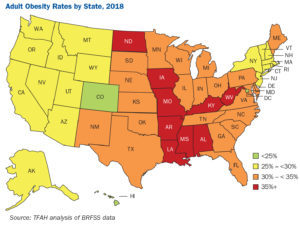 Potential Covid DeathsWhat would actually improve public health is reducing the number of people at risk of dying by COVID-19. That means reducing the number of people suffering from heart disease, hypertension, cancer, chronic respiratory disease, stroke, Alzheimer’s, obesity, and diabetes. How can we do that? A third of the country is obese! Half of US adults have heart disease! Half are pre-diabetic! Wouldn’t it be ridiculously expensive to make people healthy enough that COVID-19 is no longer a threat to them? (Of course, hasn’t shutting down our entire economy for two months been a tiny bit expensive?)
Potential Covid DeathsWhat would actually improve public health is reducing the number of people at risk of dying by COVID-19. That means reducing the number of people suffering from heart disease, hypertension, cancer, chronic respiratory disease, stroke, Alzheimer’s, obesity, and diabetes. How can we do that? A third of the country is obese! Half of US adults have heart disease! Half are pre-diabetic! Wouldn’t it be ridiculously expensive to make people healthy enough that COVID-19 is no longer a threat to them? (Of course, hasn’t shutting down our entire economy for two months been a tiny bit expensive?)Luckily there’s a way to make the entire population of the United States healthier in a few short months. And it will cost almost no money. And it will improve mental and emotional health. And it will improve social cohesion. However, no corporation will profit, and no politician will gain campaign donations because of it, so no public official will suggest it.
The magic answer? Simply have every American adult walk for 30 minutes a day. Among trees, if possible. Every day. Without masks. Without fail. No matter how old you are, how sick you are, how much you weigh, your health will improve. (Cutting out all soda and eating some vegetables will help, too. Just saying.) Walking moderately briskly 30 minutes a day reverses heart disease, reverses Type II diabetes, reverses hypertension. It reduces stress and chronic pain. It prevents strokes and Alzheimer’s; it reduces the risk of dying from breast, colon, and uterine cancer and can stop prostate cancer in its tracks. It reduces inflammation in the body. It boosts brain health. It reduces anxiety and increases happiness. Plus it relieves moderate and major depression better than pharmaceuticals or psychotherapy. Walking in your neighborhood creates local social cohesion better than just about anything. (Even more so if you smile, nod and give little waves.) Plus, it stimulates your immune system so you'll be less likely to come down with COVID-19 even if directly exposed to it. (The exception is those front line workers getting a heavy viral load, like health and transit workers. It’s criminal that they didn’t get serious personal protection at work from the very beginning.)
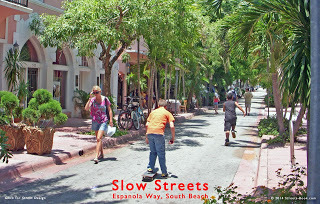 In cities, as many streets as necessary should be closed to cars to allow comfortable walking by large numbers of people. (They are not all going to fit on the sidewalk!) News media should remind people daily to go walk; social media should be full of encouragement as well. Instead of fear, fear, fear, the message should be walk, walk, walk. Walk our way out of this pandemic. Walk our way to health.
In cities, as many streets as necessary should be closed to cars to allow comfortable walking by large numbers of people. (They are not all going to fit on the sidewalk!) News media should remind people daily to go walk; social media should be full of encouragement as well. Instead of fear, fear, fear, the message should be walk, walk, walk. Walk our way out of this pandemic. Walk our way to health.If we did this, the overall US death rate would drop by half, US health care costs would plummet, US life expectancy would increase, and people would be remarkably calmer and happier. Pharmaceutical companies and health care providers might be less than thrilled, but you can’t please everyone.
So let’s walk our way out of this pandemic. Walk our way to mental, emotional and physical health. Walk our way back to social cohesion. Walk our way back to a functional society where anger and suspicion aren’t the normal ways we interact with each other. Yes, it’s actually that simple. It won’t solve wealth inequality and social injustice, but if we don’t do it, given our running-on-fumes social cohesion and the deep unhealthiness of the American population, casualties are going to be high.<!-- /* Font Definitions */ @font-face {font-family:"MS 明朝"; mso-font-charset:78; mso-generic-font-family:auto; mso-font-pitch:variable; mso-font-signature:-536870145 1791491579 18 0 131231 0;} @font-face {font-family:"MS 明朝"; mso-font-charset:78; mso-generic-font-family:auto; mso-font-pitch:variable; mso-font-signature:-536870145 1791491579 18 0 131231 0;} @font-face {font-family:Cambria; panose-1:2 4 5 3 5 4 6 3 2 4; mso-font-charset:0; mso-generic-font-family:auto; mso-font-pitch:variable; mso-font-signature:-536870145 1073743103 0 0 415 0;} /* Style Definitions */ p.MsoNormal, li.MsoNormal, div.MsoNormal {mso-style-unhide:no; mso-style-qformat:yes; mso-style-parent:""; margin:0in; margin-bottom:.0001pt; mso-pagination:widow-orphan; font-size:12.0pt; font-family:Cambria; mso-ascii-font-family:Cambria; mso-ascii-theme-font:minor-latin; mso-fareast-font-family:"MS 明朝"; mso-fareast-theme-font:minor-fareast; mso-hansi-font-family:Cambria; mso-hansi-theme-font:minor-latin; mso-bidi-font-family:"Times New Roman"; mso-bidi-theme-font:minor-bidi;} .MsoChpDefault {mso-style-type:export-only; mso-default-props:yes; font-family:Cambria; mso-ascii-font-family:Cambria; mso-ascii-theme-font:minor-latin; mso-fareast-font-family:"MS 明朝"; mso-fareast-theme-font:minor-fareast; mso-hansi-font-family:Cambria; mso-hansi-theme-font:minor-latin; mso-bidi-font-family:"Times New Roman"; mso-bidi-theme-font:minor-bidi;}size:8.5in 11.0in; margin:1.0in 1.25in 1.0in 1.25in; mso-header-margin:.5in; mso-footer-margin:.5in; mso-paper-source:0;} div.WordSection1 {page:WordSection1;}</style>
March 7, 2020
Fourteen Low-Tech Ways to Stay Healthy (Besides Handwashing)
 Health is not just an absence of illness. At the very least health includes a well-functioning immune system, our bodies’ first defense against pathogens that cause disease. This includes COVID-19, the coronavirus.
Health is not just an absence of illness. At the very least health includes a well-functioning immune system, our bodies’ first defense against pathogens that cause disease. This includes COVID-19, the coronavirus.We are all constantly exposed to bacteria, viruses, and parasites even if we wash our hands twenty times a day. If our immune system is working well, it creates a barrier that stops the antigens from entering the body altogether. This is the first line of defense. If this fails, the second line is for the immune system to produce white blood cells, chemicals and proteins that find, attack and destroy the antigens before they can reproduce. If that fails, the immune system destroys the antigens as they multiply. If the antigens are able to multiply a lot you will feel lousy as your body fights the disease in earnest. You will have unpleasant symptoms. A large part of your energy will go towards your immune system's battle. You will be sick.
I don’t know about you, but I want to stay at defense levels one and two. And this is more than possible, even with the coronavirus. Don’t get me wrong—handwashing and not touching your face does reduce the amount of pathogens that make it to your immunity barrier, but it doesn’t eliminate them entirely unless you live in a special isolation bubble. To be healthy, you also need your immune system functioning robustly. The following suggestions (to do before you become sick) may strike you as common sense, but, to paraphrase Voltaire, in the middle of a pandemic common sense is sometimes not so common.
1. Walk. Walking is a miracle remedy that, among its many wonders, boosts the immune system in a dramatic way. Other physical activities are also good, but if you’re reluctant to go the gym or yoga class due to exposure concerns, a brisk 30-minute walk won’t require you to get close to others or touch anything. To keep the immune system on high function you need 30 minutes of moderate exercise every day. Not three hours on a weekend. 30 minutes every day. 2. Cut out sugar. Yes, this includes donuts. Sugar is addictive and hidden in every nook and cranny of the standard American diet. High blood sugar suppresses your immune system. Even food items that say "healthy" often have added sugars. Read labels and don’t buy anything with more than 2 grams of added sugars per serving. Don’t drink anything with added sugar or high fructose corn syrup. If this seems like agony, give yourself permission to have one tinysweet thing a day. But really, once you cut added sugars out of your diet, your taste buds will recalibrate and you’ll find many things in a healthy diet are naturally sweet and satisfying.3. Don't binge drink alcohol. Remember that alcohol is addictive and toxic to the human body. I’m not saying don’t drink at all—I like my wine, too—but treat it with the caution it deserves. Three drinks in an evening impact the immune system. Five drinks in an evening really mess up the immune system. 4. Cut out junk/fast food. An unhealthy diet generates a cascade of negative biological effects that extend over a surprising period of time. One of those effects is a messed up immune system. If you want to be healthy, you have to eat for nutrition, not for convenience, not for emotional comfort, and not to satisfy cravings for salt/fat/sugar. But this doesn’t have to be a sacrifice. Healthy foods cooked with healthy fats can be delicious, truly. 5. Stop smoking. Smoking damages immune response and especially increases susceptibility to pneumonia. This is one of the reasons that COVID-19 is killing so many more men than women in China—men are fifty times heavier smokers there. 6. Sleep enough, at least 7 hours a night. Any less and your T-cells are affected. T-cells are especially important for your immune system to effectively fight viruses. Ways to get more sleep—go to bed 30 minutes earlier, cut out caffeine and alcohol, exercise during the day, sleep in a cool, dark room without electronics, don’t have cats that wake you up in the middle of the night like I do.7. Sweat/steam—Isak Dinesen said the cure for anything is salt water—sweat, tears or the sea. Fifteen minutes in a sauna will increase white blood cell count and stimulate your immune system. If you feel chilled or a little off, it really can head a virus off at the pass.8. Avoid wood fires except in high efficiency wood stoves or fireplace inserts. Breathing wood smoke is surprisingly bad for you, and wood-burning fireplaces tend to create a lot of smoke, both indoors and out. Among other things, the chemicals in wood smoke impede pulmonary immune response and increase susceptibility to respiratory infections. Also a good idea to avoid car and diesel exhaust.9. Don’t get chilled. Don’t go outside with wet hair. Don’t allow your feet to remain wet. This is different than don’t go out in the cold or don’t walk in the rain. Proper clothing will keep you warm and dry. But if your body temperature drops, key immune system proteins are impaired, making it more likely for viruses to replicate. Dry your hair! Change out of wet shoes/wet socks as soon as you can! (Yes, I know I sound like your mom. I still say these things to my adult children.)10. Listen to your body. Sometimes, if you feel a bit off--on the verge of coming down with something—if you give your immune system a boost right then you can kick whatever’s looming. A nice walk might work, or a hot bath, or an early bed. Or some form of tonic or pick-me-up might appeal. Some things I’ve found that work for me (your mileage may vary): chicken bone broth with lemon and cayenne, cherry bark syrup, fire cider vinegar, three roots tea (licorice/ginger/turmeric). What works for you? Put it in the comments!11. Healthy food. Brightly-colored veggies, berries, mushrooms, and garlic all have immune boosting properties. 12.Reduce stress. Chronic stress hammers the immune system. Reduce the impact through meditation, exercise, counseling and/or social support. Just to note: chronic fear creates chronic stress. Wigging out about the corona virus is not what you want to spend your day doing.13.Increase happiness/kindness. Depression and loneliness suppress the immune system, happinessand kindness boost it. For ways to decrease your unhappiness and increase your happiness read this.14.Get out in sunlight/nature. Huddling inside obsessing on the internet is not good for your health. Being outside in nature and sunlight is.
Your health is not random, nor is it predetermined. You have immense influence over it. Don’t just stock up on toilet paper and hand sanitizer—take active steps to bolster your body's built-in, sophisticated disease-conquering mechanism. Most healthy people under 70 who are exposed to the coronavirus either don’t get sick or are ill just a few days. If the horse is already out of the barn in your area (i.e. the virus has already been circulating for weeks,) for your family’s sake and for your community’s sake, you want the virus to bounce right off you if you’re exposed to it. In this way you won’t fill a hospital bed or need a ventilator or require drugs that might be in short supply. In this way, you can take care of family members who fall ill. In this way, you can go shopping or prepare meals or mow the lawn for a neighbor in need. Plus, being healthy, you’ll feel great! Taking time for your health is not selfish, it’s how you can actively contribute to the greater good. If schools end up closed in your region, feed your kids healthy food and let them be active. If playgrounds seem a risk, take them on bike rides and hikes in nature. It will be good for you all!
Note: This is not medical advice. If you are ill, consult your health care provider.<!-- /* Font Definitions */ @font-face {font-family:"MS 明朝"; mso-font-charset:78; mso-generic-font-family:auto; mso-font-pitch:variable; mso-font-signature:-536870145 1791491579 18 0 131231 0;} @font-face {font-family:"Cambria Math"; panose-1:2 4 5 3 5 4 6 3 2 4; mso-font-charset:0; mso-generic-font-family:auto; mso-font-pitch:variable; mso-font-signature:-536870145 1107305727 0 0 415 0;} @font-face {font-family:Cambria; panose-1:2 4 5 3 5 4 6 3 2 4; mso-font-charset:0; mso-generic-font-family:auto; mso-font-pitch:variable; mso-font-signature:-536870145 1073743103 0 0 415 0;} /* Style Definitions */ p.MsoNormal, li.MsoNormal, div.MsoNormal {mso-style-unhide:no; mso-style-qformat:yes; mso-style-parent:""; margin:0in; margin-bottom:.0001pt; mso-pagination:widow-orphan; font-size:12.0pt; font-family:Cambria; mso-ascii-font-family:Cambria; mso-ascii-theme-font:minor-latin; mso-fareast-font-family:"MS 明朝"; mso-fareast-theme-font:minor-fareast; mso-hansi-font-family:Cambria; mso-hansi-theme-font:minor-latin; mso-bidi-font-family:"Times New Roman"; mso-bidi-theme-font:minor-bidi;} p.MsoListParagraph, li.MsoListParagraph, div.MsoListParagraph {mso-style-priority:34; mso-style-unhide:no; mso-style-qformat:yes; margin-top:0in; margin-right:0in; margin-bottom:0in; margin-left:.5in; margin-bottom:.0001pt; mso-add-space:auto; mso-pagination:widow-orphan; font-size:12.0pt; font-family:Cambria; mso-ascii-font-family:Cambria; mso-ascii-theme-font:minor-latin; mso-fareast-font-family:"MS 明朝"; mso-fareast-theme-font:minor-fareast; mso-hansi-font-family:Cambria; mso-hansi-theme-font:minor-latin; mso-bidi-font-family:"Times New Roman"; mso-bidi-theme-font:minor-bidi;} p.MsoListParagraphCxSpFirst, li.MsoListParagraphCxSpFirst, div.MsoListParagraphCxSpFirst {mso-style-priority:34; mso-style-unhide:no; mso-style-qformat:yes; mso-style-type:export-only; margin-top:0in; margin-right:0in; margin-bottom:0in; margin-left:.5in; margin-bottom:.0001pt; mso-add-space:auto; mso-pagination:widow-orphan; font-size:12.0pt; font-family:Cambria; mso-ascii-font-family:Cambria; mso-ascii-theme-font:minor-latin; mso-fareast-font-family:"MS 明朝"; mso-fareast-theme-font:minor-fareast; mso-hansi-font-family:Cambria; mso-hansi-theme-font:minor-latin; mso-bidi-font-family:"Times New Roman"; mso-bidi-theme-font:minor-bidi;} p.MsoListParagraphCxSpMiddle, li.MsoListParagraphCxSpMiddle, div.MsoListParagraphCxSpMiddle {mso-style-priority:34; mso-style-unhide:no; mso-style-qformat:yes; mso-style-type:export-only; margin-top:0in; margin-right:0in; margin-bottom:0in; margin-left:.5in; margin-bottom:.0001pt; mso-add-space:auto; mso-pagination:widow-orphan; font-size:12.0pt; font-family:Cambria; mso-ascii-font-family:Cambria; mso-ascii-theme-font:minor-latin; mso-fareast-font-family:"MS 明朝"; mso-fareast-theme-font:minor-fareast; mso-hansi-font-family:Cambria; mso-hansi-theme-font:minor-latin; mso-bidi-font-family:"Times New Roman"; mso-bidi-theme-font:minor-bidi;} p.MsoListParagraphCxSpLast, li.MsoListParagraphCxSpLast, div.MsoListParagraphCxSpLast {mso-style-priority:34; mso-style-unhide:no; mso-style-qformat:yes; mso-style-type:export-only; margin-top:0in; margin-right:0in; margin-bottom:0in; margin-left:.5in; margin-bottom:.0001pt; mso-add-space:auto; mso-pagination:widow-orphan; font-size:12.0pt; font-family:Cambria; mso-ascii-font-family:Cambria; mso-ascii-theme-font:minor-latin; mso-fareast-font-family:"MS 明朝"; mso-fareast-theme-font:minor-fareast; mso-hansi-font-family:Cambria; mso-hansi-theme-font:minor-latin; mso-bidi-font-family:"Times New Roman"; mso-bidi-theme-font:minor-bidi;} .MsoChpDefault {mso-style-type:export-only; mso-default-props:yes; font-family:Cambria; mso-ascii-font-family:Cambria; mso-ascii-theme-font:minor-latin; mso-fareast-font-family:"MS 明朝"; mso-fareast-theme-font:minor-fareast; mso-hansi-font-family:Cambria; mso-hansi-theme-font:minor-latin; mso-bidi-font-family:"Times New Roman"; mso-bidi-theme-font:minor-bidi;}size:8.5in 11.0in; margin:1.0in 1.25in 1.0in 1.25in; mso-header-margin:.5in; mso-footer-margin:.5in; mso-paper-source:0;} div.WordSection1 {page:WordSection1;}mso-level-number-format:roman-lower; mso-level-tab-stop:none; mso-level-number-position:right; text-indent:-9.0pt;} ol {margin-bottom:0in;} ul {margin-bottom:0in;}</style>
February 8, 2020
The Habits of Unhappy People (and What You Can Do About Them)
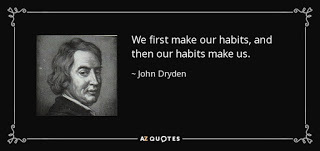 Some habits make us unhappy. Others reveal unhappiness. Some do both. A healthy society strives to nurture the well-being of its members, because secure, stable people who find satisfaction in life can work together, innovate, adapt to change, and problem-solve effectively. A country full of miserable, angry people who spend their time blotting out their pain or lashing out at others can cope with almost nothing.
Some habits make us unhappy. Others reveal unhappiness. Some do both. A healthy society strives to nurture the well-being of its members, because secure, stable people who find satisfaction in life can work together, innovate, adapt to change, and problem-solve effectively. A country full of miserable, angry people who spend their time blotting out their pain or lashing out at others can cope with almost nothing.Because unhappiness is stigmatized, it’s very possible for someone to be in denial of their unhappiness even when evidence abounds. Indeed, we are all likely in denial of at least a few habits that actively increase our unhappiness.
There's lots of research on what makes people happy and unhappy. Lots and lots. (Click on the links below if you're interested.) What follows is a partial list of the habits of unhappy people and what instigates them. To be sure, these behaviors don't affect everyone in identical fashion. Whether these habits contribute to your unhappiness is entirely for you to decide.
The Habits
--Name dropping, bragging, exaggerating your achievements and talents (Evidence of insecurity.)
--Holding grudges, obsessively hating. (Evidence of anger and also fans its flames.)
--Blaming others, denying responsibility, complaining, being helpless or passive, always framing oneself as a victim (Evidence of fear/anxiety/insecurity/shame/guilt.)
--Insulting/bullying/mocking/demeaning others others. (Evidence of insecurity/shame.)
--Lying, cheating. (Evidence of insecurity/fear/shame/anxiety.)
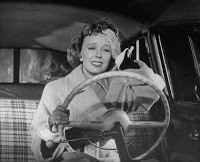 --Being sedentary, long commutes, driving in traffic. (Cause of stress, depression, anger, anxiety, poor health.)
--Being sedentary, long commutes, driving in traffic. (Cause of stress, depression, anger, anxiety, poor health.)--Watching a lot of TV/commercials (Cause of poor health/insecurity/frustration/ passivity, sometimes evidence of anxiety, grief, depression.)
--Stewing in existential angst, including climate change angst. (Evidence of anxiety/fear/despair, can reinforce all three.)
--Spending hours each day watching or reading news (Evidence of anxiety, cause of anxiety/anger/frustration/hopelessness.)
--Arguing a lot, angry tweets, going off in rages, horn honking, driving recklessly or with hostility. (Evidence of low self-worth/anger.)
--Enjoying the pain of others, inflicting pain on others, fantasizing about inflicting pain on others, cruelty to animals. (Evidence of anger/self-hatred/perhaps shame/inability to empathize, cause of anger/guilt.)
--Prone to aggression, domestic violence.(Evidence of anger/insecurity/low self-esteem.)
--Frequent impatience, frustration, feeling stressed (Evidence of anger/unhappiness from lack of control.)
--Ruminating on the negative, negative self-talk, being pessimistic. (Evidence of fear/grief/low self-esteem, cause of fear/depression/low self-esteem.)
----Eating junk food/processed food/too much caffeine. (Cause of poor health/irritability./depression.)
--Garden-variety selfishness. Being inconsiderate, rude, not taking one’s turn, not taking into account needs of others. (Can be evidence of fear/insecurity/anxiety/depression. Can also be evidence of bad upbringing that didn’t cultivate empathy.)
--Artificial mood lifters--binge eating/sugar/carbs/smoking/alcohol/drug use/compulsive shopping. (Evidence of anxiety/anger/depression/psychic pain, cause of shame/anger/addiction/poor health.)
--Frowning, slumping when sitting or walking (Evidence of anger/stress/sadness, cause of/amplifies depression, stress, sadness)
--Chasing status, material goods, spending lots of time on social media. (Evidence of insecurity/fear/low self-esteem/loneliness, cause of resentment/fear/insecurity/low self-esteem/anger/anxiety/depression/loneliness.)
--Hoarding, living in chaos/mess (Evidence of anxiety, cause of shame/stress/anxiety)
--Social isolation, prolonged grief. (Evidence of fear/depression/anxiety, cause of depression/poor health.)
--Little time spent in nature, too little exposure to sunlight. (Cause of depression/poor health)
--Carrying around big bags of emotional rocks/not letting stuff go. (Cause of depression/frustration/low self-esteem/anger.)
--Black/white thinking—us/them, winners/losers, good/evil, etc. (“If only they (insert group of choice) didn’t exist, everything would be fine.) (Evidence and cause of anger/fear/resentment)
Hey, we’ve all done some of the above. I’m guilty of many myself at one time or another. The point is not to be perfect or eliminate every possible negative action from our lives. Nor is the point to excuse these behaviors, which can often be quite hurtful to others. The point is to recognize and reduce the ways we contribute to our own unhappiness and increase the ways we boost our well-being.
 Our level of well-being is a byproduct of how we live our lives. It's the result of the big decisions we make but also the cumulative behaviors that fill our days. You can think of your mood as your emotional weather, and your level of contentment/discontent as your emotional climate. There are two important ways in which this metaphor fails. You can’t change the weather but you can change your mood. And unhappiness tends to beget more unhappiness. (There’s a reason Eeyore walks under a perpetual rain cloud.) So breaking the cycle helps. Regardless of anything else, you deserve to enjoy your life. Being miserable will not solve your problems, it won't solve the world's problems, but it will sap your energy and your health. Sure you won't always walk around in perpetual bliss, and chasing sheer hedonistic gratification can be a great way to ruin your life. Still, eliminating habits that make you unhappy really does help.
Our level of well-being is a byproduct of how we live our lives. It's the result of the big decisions we make but also the cumulative behaviors that fill our days. You can think of your mood as your emotional weather, and your level of contentment/discontent as your emotional climate. There are two important ways in which this metaphor fails. You can’t change the weather but you can change your mood. And unhappiness tends to beget more unhappiness. (There’s a reason Eeyore walks under a perpetual rain cloud.) So breaking the cycle helps. Regardless of anything else, you deserve to enjoy your life. Being miserable will not solve your problems, it won't solve the world's problems, but it will sap your energy and your health. Sure you won't always walk around in perpetual bliss, and chasing sheer hedonistic gratification can be a great way to ruin your life. Still, eliminating habits that make you unhappy really does help.Unhappiness is usually a byproduct of stress, anger, insecurity, unhealed trauma, frustration, low self-esteem, poor health, hunger not under your control, lack of belonging/connection, or lack of life purpose/meaning. Sometimes tackling an unhappiness habit requires addressing the underlying emotion/cause, but sometimes just changing an external habit brings about remarkable internal change. Of course there are many factors outside of one’s personal control that cause unhappiness. They include wealth inequality, being abused as a child, sexual abuse, death of a loved one, a dangerous environment that prevents walking/exercising outdoors, living in a food desert, no access to or money for food, no access to nature, being the victim of violence, loud noise, lack of control at work, unloving parents, physical pain, toxic people you can’t escape, being harassed, shamed, demeaned, threatened or intimidated, incarceration, grief, pollution, litter, and ugliness. (Partial list! What would you add?) There are good reasons for our society to prevent or reduce the above factors as much as possible, and it’s true that sometimes getting oneself away from a toxic situation or person can reduce unhappiness dramatically. But people tend to vastly underrate the power of personal habits that are within our direct control.
Habits that boost well-being: walking, biking, yoga, tai chi, sports (if emphasis is on fun and camaraderie), time in nature, tree canopies, flowers, being grateful, keeping a gratitude journal, being kind, being optimistic, limiting time on social media, not eating processed food, eating enough healthy proteinand vegetables, meditation, dancing, gardening, being optimistic, limiting alcohol, limiting caffeine, positive connection with others, smiling, sitting and standing with good posture, acknowledging but not dwelling on negative emotions, reframing problems, calming techniques, frustration reduction techniques, massage, sunlight, creating art, meaningful work, finding meaning in life, cutting out sugar, community service, pets, and music that you like. What happiness boosters work for you? Making a list like this for you in particular and holding it close to your heart (metaphorically) is a very good idea. For unresolved trauma, counseling or deep internal work can help you heal. It's important to notice what's not on this list: money. That's because beyond a certain level of income, money doesn't make people any happier. (It depends on family size and cost of living, but in the US happiness starts plateauing around $75K.) People who win the lottery two years later are no more or less happy than random people selected from the phone book.
 We unconsciously perceive unhappiness as contagious (in some ways it is) and avoid those who are obviously unhappy. This is one of the reasons people deny, ignore, or conceal their unhappiness. But not everyone who is unhappy is toxic. Indeed, some go on to live admirable lives despite their unhappiness, a good example being Abraham Lincoln who had a raft of private and public sorrows but still managed to be an exemplary human being. (Maybe because, remarkably, he had very few unhappiness habits.)
We unconsciously perceive unhappiness as contagious (in some ways it is) and avoid those who are obviously unhappy. This is one of the reasons people deny, ignore, or conceal their unhappiness. But not everyone who is unhappy is toxic. Indeed, some go on to live admirable lives despite their unhappiness, a good example being Abraham Lincoln who had a raft of private and public sorrows but still managed to be an exemplary human being. (Maybe because, remarkably, he had very few unhappiness habits.)I’m writing about unhappiness for two reasons. The first is because I want to live in a world full of functional people that aren’t committing slow suicide in misery. We are all connected, every single living thing on this planet, so even if we never meet, your well-being affects my own.
The second reason is that if you can recognize the habits of unhappy people for what they are, you can step out of the drama and be far less affected by them. Often the behavior that drives you the most crazy is the one that resonates with you unconsciously. The one you’re in denial about. Yep, you’ve got to look at it. Becoming conscious of a habit is both a necessary and powerful first step towards addressing it.
When you interact with people who are unhappy, you don’t have to solve their problems for them. You probably can’t anyway. But you can be kind. And the first principle of being kind is to not take their negative energy, wad it into a ball, and throw it back in their face to teach them a lesson. If the person is harming you or others, you may have to intervene, but most unhappy people hurt themselves more than others. If you can manage not to participate in the drama, you can defuse it. You de-escalate. You make it possible for the other person to make a shift. Maybe they will, maybe they won’t, but not reinforcing their negative spiral has more power than you might think. And once you understand that their behavior comes from unhappiness, it will make you less frustrated and crazy, which means your happiness will increase. Benefits all around.
Bonus tip #1: If alcohol is adding to your unhappiness, a powerful book is This Naked Mind .
Bonus tip #2: If you want a surefire way to increase your happiness, get an electric bike. I’m not kidding. Try it.
Karen Lynn Allen is an author working on a new set of novels, a trilogy called The Radiant Engineer about a society that goes into a descent and then climbs out of it.<!-- /* Font Definitions */ @font-face {font-family:"MS 明朝"; mso-font-charset:78; mso-generic-font-family:auto; mso-font-pitch:variable; mso-font-signature:-536870145 1791491579 18 0 131231 0;} @font-face {font-family:"Cambria Math"; panose-1:2 4 5 3 5 4 6 3 2 4; mso-font-charset:0; mso-generic-font-family:auto; mso-font-pitch:variable; mso-font-signature:-536870145 1107305727 0 0 415 0;} @font-face {font-family:Cambria; panose-1:2 4 5 3 5 4 6 3 2 4; mso-font-charset:0; mso-generic-font-family:auto; mso-font-pitch:variable; mso-font-signature:-536870145 1073743103 0 0 415 0;} /* Style Definitions */ p.MsoNormal, li.MsoNormal, div.MsoNormal {mso-style-unhide:no; mso-style-qformat:yes; mso-style-parent:""; margin:0in; margin-bottom:.0001pt; mso-pagination:widow-orphan; font-size:12.0pt; font-family:Cambria; mso-ascii-font-family:Cambria; mso-ascii-theme-font:minor-latin; mso-fareast-font-family:"MS 明朝"; mso-fareast-theme-font:minor-fareast; mso-hansi-font-family:Cambria; mso-hansi-theme-font:minor-latin; mso-bidi-font-family:"Times New Roman"; mso-bidi-theme-font:minor-bidi;} .MsoChpDefault {mso-style-type:export-only; mso-default-props:yes; font-family:Cambria; mso-ascii-font-family:Cambria; mso-ascii-theme-font:minor-latin; mso-fareast-font-family:"MS 明朝"; mso-fareast-theme-font:minor-fareast; mso-hansi-font-family:Cambria; mso-hansi-theme-font:minor-latin; mso-bidi-font-family:"Times New Roman"; mso-bidi-theme-font:minor-bidi;}size:8.5in 11.0in; margin:1.0in 1.25in 1.0in 1.25in; mso-header-margin:.5in; mso-footer-margin:.5in; mso-paper-source:0;} div.WordSection1 {page:WordSection1;}</style>
April 12, 2019
Why Don't You Have an Electric Bike Already?
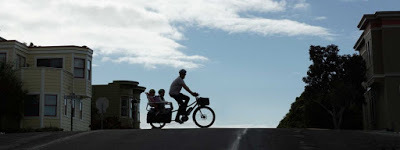 Top of the World!If you’re already making most of your daily trips by bike or on foot, you don’t need to read further. An electric bike is unlikely to improve your life. For everyone else, read on!
Top of the World!If you’re already making most of your daily trips by bike or on foot, you don’t need to read further. An electric bike is unlikely to improve your life. For everyone else, read on!Would you like to be stronger and smarter? Would you like to be happier and healthier? Would you like to keep depression at bay without medication? Would you like to reduce your stress by 40% and sleep better? Would you like to do all this in everyday clothes, without sweating, and have fun while you’re at it?
It’s time to get an electric bike. It will change your life. Seriously. I’m not kidding.
 (Mark Markovich, BikePortland.org)If you don’t bike now because you live in a hilly area, electric bikes make hills flat. If you don’t bike now because you don’t like to get sweaty, an electric bike means you don’t have to get sweaty at all if you choose. (If you can walk without sweating, you can e-bike without sweating. If you can’t walk without sweating, you have a health emergency you need to deal with pronto.) If you don’t bike now because you have to cart around children or groceries, an electric cargo bike will do both for you in a snap. If you don’t bike now because you don’t have time, you will find an electric bike is as fast as a car for distances under five miles, and in heavy traffic for distances under ten miles. If you don’t bike now because you always have to drive more than five miles for your daily trips, you’re probably overestimating how far away your daily errands really take you. If you don’t bike now because the drivers in your town are freaking maniacs, well, we’ll talk about that.
(Mark Markovich, BikePortland.org)If you don’t bike now because you live in a hilly area, electric bikes make hills flat. If you don’t bike now because you don’t like to get sweaty, an electric bike means you don’t have to get sweaty at all if you choose. (If you can walk without sweating, you can e-bike without sweating. If you can’t walk without sweating, you have a health emergency you need to deal with pronto.) If you don’t bike now because you have to cart around children or groceries, an electric cargo bike will do both for you in a snap. If you don’t bike now because you don’t have time, you will find an electric bike is as fast as a car for distances under five miles, and in heavy traffic for distances under ten miles. If you don’t bike now because you always have to drive more than five miles for your daily trips, you’re probably overestimating how far away your daily errands really take you. If you don’t bike now because the drivers in your town are freaking maniacs, well, we’ll talk about that.The benefits to cycling are legion. If a pill or a gadget could make you happy, improve your immune function, make you less likely to take sick days, make you less likely to get depressed, cure your depression better than current medications, give you more energy throughout the day, help you sleep, improve your skin, promote your brain health, prevent heart disease and type 2 diabetes, prevent dementia, reverse heart disease and diabetes, prevent multiple kinds of cancer, help you age well, and help you stay mobile and active until a few short years before your death, you would see people standing in line for days to purchase it. But the fact is exercise can accomplish all of the above for you. Indeed, 30 minutes of exercise a day is basically a wonder drug that is cheap, available to all, and has few side effects. Since you already have errands and commutes to do, walking or biking these trips is an easy way to ensure you get your vital 30 minutes a day. I’m a big fan of walking, but due to how our poorly US suburbs are designed (as opposed to The Ten Minute Neighborhood) most people can do few of their daily trips on foot. However, daily trips on an e-bike are very doable because e-bikes are just that great. Even better, they’re fun. Really fun. And they’re the most energy efficient mode of travel on the planet.
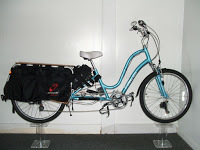 My awesome E-bikeHard-core bicyclists are quick to object to e-bikes as hardly counting as exercise, but this isn’t true. With a pedal-assist e-bike (that only kicks in if you pedal) you expend 70-80% of the calories you’d expend on a regular bike over the same time period, depending on terrain, of course. I live in San Francisco, land of big hills. On flat pavement, I am most comfortable biking at about 12 mph on my regular bike, and about 15 on my e-bike, not counting waiting for lights. I cover distances faster on my e-bike, especially returning home since I live up a big hill, so I burn fewer calories on my e-bike because of the shorter rides. However, once I got my electric bike, I replaced many, many car trips with e-bike trips, so net I have a lot more calorie expenditure. I still use my regular bike when I want to get more serious exercise, but to zip down to the store? To go to the symphony? To go to my evening tai chi class? It’s electric bike all the way.
My awesome E-bikeHard-core bicyclists are quick to object to e-bikes as hardly counting as exercise, but this isn’t true. With a pedal-assist e-bike (that only kicks in if you pedal) you expend 70-80% of the calories you’d expend on a regular bike over the same time period, depending on terrain, of course. I live in San Francisco, land of big hills. On flat pavement, I am most comfortable biking at about 12 mph on my regular bike, and about 15 on my e-bike, not counting waiting for lights. I cover distances faster on my e-bike, especially returning home since I live up a big hill, so I burn fewer calories on my e-bike because of the shorter rides. However, once I got my electric bike, I replaced many, many car trips with e-bike trips, so net I have a lot more calorie expenditure. I still use my regular bike when I want to get more serious exercise, but to zip down to the store? To go to the symphony? To go to my evening tai chi class? It’s electric bike all the way.I’ve been a driver for over forty years. Our household used to own two cars, and I used to personally drive more than 10,000 miles a year, most of it on complex San Francisco city streets. I totally get that cars are convenient and that it can be enraging in a very primal way to share street space with cyclists. My husband and I now own just a 2004 Prius that we drive less than 4000 miles a year total, most of that on trips out of town. If you’ve never ridden an electric bike, you may not believe this, but the switch from car driving to biking is liberating. What most people don’t realize is that riding an e-bike is just about as fast, and often faster, than driving a car or taking Lyft or Uber. What people also don’t realize is that driving or sitting in a car makes you sedentary just as much as watching TV does. It’s possible to be a little overweight and healthy. It is not possible to be sedentary and healthy. Our bodies need movement to function properly. It’s as simple as that.
Let’s take a 150 lb person and examine their average calorie burn per 30 minutes of activity, the exercise being on the moderate side.Watching TV—28Car driving—34Reading, sitting—42Computer work—51Sitting in meetings—60Walking 3.5 mph (17 min/mi)—149E-biking 12 – 14 mph--223Regular bicycling 12 – 14 mph—298
As you can see, regular biking is more exercise than e-biking, but both are much, much better than sitting on your butt driving. Time squandered sitting on your butt trapped in your car is time you could’ve put towards health and happiness. I know you’re still not convinced. Read on!
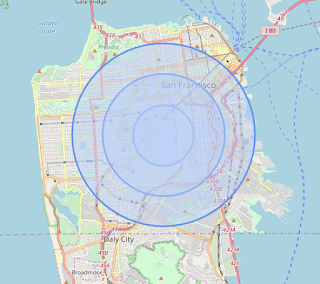 Circles of Daily LifeYour daily errands are closer than you think. Here’s a great mapping tool. Use it to draw three circles centered on your home with radii one, two and three miles. To left are my three circles. I live in a congested part of the city where there is a light or stop sign every single block. Which means I am stopping every 15 - 30 seconds. On my e-bike I can pretty much get to every destination in the inner circle in 6 - 7 minutes. The second circle 10 – 12 minutes. The outside edge of the third circle I’m confident I can get to in 18 - 20 minutes, faster if I hit the lights right. As you can see, most of San Francisco is within a 20 minute e-bike ride. And this is with constant stops in the second densest city in North America. I’m sure you can do much better.
Circles of Daily LifeYour daily errands are closer than you think. Here’s a great mapping tool. Use it to draw three circles centered on your home with radii one, two and three miles. To left are my three circles. I live in a congested part of the city where there is a light or stop sign every single block. Which means I am stopping every 15 - 30 seconds. On my e-bike I can pretty much get to every destination in the inner circle in 6 - 7 minutes. The second circle 10 – 12 minutes. The outside edge of the third circle I’m confident I can get to in 18 - 20 minutes, faster if I hit the lights right. As you can see, most of San Francisco is within a 20 minute e-bike ride. And this is with constant stops in the second densest city in North America. I’m sure you can do much better. While looking at your three circles, think about all the trips you made in the last week. How many fit in the first circle? If you don’t live in a city, maybe not many. How many fit in the second circle? Probably quite a few. How many in the third? All these trips you can easily bike to, and it probably won’t take much longer than driving and parking (maybe a minute or two more?) If you go during heavy congestion times, e-biking is likely faster than driving, plus it’s lots of fun zipping past cars stuck in traffic.
I’ll give a case of going to my acupuncturist. Her office is 2.2 miles away, on a bus line that stops half a block from my house. There are two substantial hills on the way if I bike.Walk—50 minMuni bus—30 min (includes 3 min walking and 8 minutes waiting)Regular bike—24 min there, 27 min home (worse hill on way home)Drive—24 min (20 min drive + park/feed meter)E-bike—15 min each way
E-bike wins hands down. It even substantially beats Lyft/Uber because while you don't have to park with rideshare, you do have to wait 1 - 5 minutes for them to pick you up.
Here’s another case. My sister lives in the suburbs of Seattle. Her closest grocery store is 2.2 miles from her house, up a big hill every time she leaves her home.Walk—44 minBus—not an option, none existsRegular bike—17 min (Google map estimate)Drive—8 – 11 min, depending on time of day (6 – 9 min drive + 2 min park/walk)E-bike—11 min
E-bike wins because it’s as fast or nearly as driving, less frustrating if there’s traffic, and better exercise.
Last case. My sister works 8 miles from her home in an industrial part of a small city.Walk—2 hrs 43 minBus—not an option, none exists (completely ridiculous, but so it goes.)Regular bike—50 minDrive—20 minutes without traffic, 40 min with traffic + 5 min walk from parking lot E-bike—35 minutes
It may seem like driving is quicker, but the fact is my sister commutes when everyone else does, when traffic is at its worst. Though 50 minutes of regular biking might leave you a bit tired and sweaty, some people might like such a workout if they’re able to shower at work. However, 35 minutes of e-biking will leave you energized, non-sweaty and perfectly ready to start your day. E bike wins.
 Serious cargo e-bikeSome of the benefits of e-bike versus regular bikes: easier on the knees, you can get built-in lights to make you very visible to motorists, they’re usually more upright, which also makes you more visible to motorists, easier to carry heavy things home, can get out of intersections faster (most dangerous places on roads with turning drivers not looking out for you like they should.) Riding into the wind or uphill is no longer a miserable experience. Cons: more expensive than a regular bike, have to worry more about it getting stolen, not as good exercise, heavier, hard to carry upstairs, harder to bring onto public transportation. The mining of elements in e-bike batteries has a negative environmental impact.
Serious cargo e-bikeSome of the benefits of e-bike versus regular bikes: easier on the knees, you can get built-in lights to make you very visible to motorists, they’re usually more upright, which also makes you more visible to motorists, easier to carry heavy things home, can get out of intersections faster (most dangerous places on roads with turning drivers not looking out for you like they should.) Riding into the wind or uphill is no longer a miserable experience. Cons: more expensive than a regular bike, have to worry more about it getting stolen, not as good exercise, heavier, hard to carry upstairs, harder to bring onto public transportation. The mining of elements in e-bike batteries has a negative environmental impact.Compared to cars e-bikes require a tiny fraction of the cost to own and operate. No need for insurance or gas, little maintenance, uses a very tiny amount of electricity (1/2 cents worth per mile.) You will never have to hunt for parking or get parking tickets. You don’t have to uselessly carry around 3000 pounds of metal with you wherever you go. No fumes, no emissions, no vibrations, no noise. All bicycles are on a human scale that is good for neighborhoods and neighborliness. Because of their far lighter weight, both bikes and e-bikes do very little damage to roads, creating in and of themselves almost no need for costly road maintenance. And all bicycles require far less land use, both when in use and when parked.
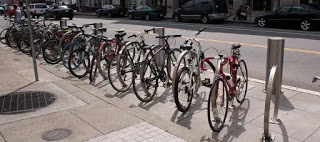 You can fit a lot of bikes in a couple car parking spots.Land use is an important point. Think of a terrible traffic jam. You’re inching along and it takes five minutes to go half a mile. Your stress builds as you realize you’re going to be late. You think not only could you bike faster, you could walk faster than your car is moving. Look around at all the cars in front and behind you. How many can you count? Forty? Fifty? If a traffic fairy waved her wand and all the cars you just counted magically turned into people on bikes, the traffic would disappear instantly. The bikes would hardly fill one lane of the road. There would be plenty of room for everyone; in fact there would be room for ten times the number. That’s how much less space bicycles take, both on the road and parked.
You can fit a lot of bikes in a couple car parking spots.Land use is an important point. Think of a terrible traffic jam. You’re inching along and it takes five minutes to go half a mile. Your stress builds as you realize you’re going to be late. You think not only could you bike faster, you could walk faster than your car is moving. Look around at all the cars in front and behind you. How many can you count? Forty? Fifty? If a traffic fairy waved her wand and all the cars you just counted magically turned into people on bikes, the traffic would disappear instantly. The bikes would hardly fill one lane of the road. There would be plenty of room for everyone; in fact there would be room for ten times the number. That’s how much less space bicycles take, both on the road and parked.Carrying children is easy with an e-cargo bike. In fact children vastly prefer it to being strapped motionless to a car seat seeing the world vaguely from behind a window. There are all sorts of kid-oriented models these days, many with rain canopies to keep your little ones dry. An added bonus to ebiking is passing the long line of cars dropping children off at school while you pull right up to the front door.
Carrying groceries or other heavy stuff is easy on an e-bike. You can use panniers, baskets, bike buckets or straps. On my Xtracycle e-bike I can carry five bags of groceries plus a twelve-pack of toilet paper. Up hill. Into the wind.
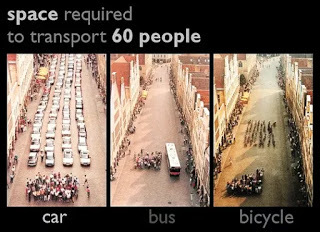 Oh, to have a traffic fairy wave her magic wand.E-bikes do require batteries that have negative environmental impact, but because the batteries are so much smaller than those of electric cars, the impact is an order of magnitude smaller. While not zero, if an ebike will allow you to downsize a car, this would be would be far, far better for the world than buying an electric car or continuing to drive your current vehicle. An e-bike battery runs 4 – 8 lbs. The Nissan Leaf battery is 403 lbs. The Tesla Model S battery is 1600 lbs. Right now there are more drivers than cars in the United States. This is insane. Replacing all of these current cars with electric cars would be insane. If two-thirds of American cars were replaced with e-bikes, the health and happiness of the US population would not only improve, people would actually get where they were going faster.
Oh, to have a traffic fairy wave her magic wand.E-bikes do require batteries that have negative environmental impact, but because the batteries are so much smaller than those of electric cars, the impact is an order of magnitude smaller. While not zero, if an ebike will allow you to downsize a car, this would be would be far, far better for the world than buying an electric car or continuing to drive your current vehicle. An e-bike battery runs 4 – 8 lbs. The Nissan Leaf battery is 403 lbs. The Tesla Model S battery is 1600 lbs. Right now there are more drivers than cars in the United States. This is insane. Replacing all of these current cars with electric cars would be insane. If two-thirds of American cars were replaced with e-bikes, the health and happiness of the US population would not only improve, people would actually get where they were going faster.I’m not going to recommend any particular brand of e-bike, but I will say that the technology has advanced substantially since I pieced my bike together with a kit I got online. (Not easily. I finally got it going well with the help of an electric bike guy in town.) Now you can get e-bikes that are entirely waterproof, with the batteries integrated into the frame, or at least encased in a goodly amount of firm plastic. My advice is not to get the cheapest e-bike you can find (it’ll just fall apart), but there are good ones to be found starting around $800, and great ones for more. Depending how often you use it, you may have to get a new battery every 3 – 5 years, so factor that into your calculations. The good news is electric brushless motors have very few moving parts and need very little maintenance. What’s more likely to go bad is the controller for the electrical system. I’ve had my bike (which was really a kluged together job) for nine years now. I’ve replaced the battery twice and the controller once. I have a 300W motor that does a great job moving me, groceries, and my 80 lb bike up very big hills. I can’t see why anyone would get a 500 Watt motor or, worse, a 750 Watt. If you have to pedal to get it going and it has a top speed of 20 mph, you don’t need that much power unless you live at the top of a volcano. Don’t get a bike with a throttle unless you know yourself well and know you’ll always pedal. Just sitting on your butt on your bike doesn’t count as exercise, plus it’ll cut your range significantly. Last piece of advice on bike choice: get a bike with an electric motor, not an electric scooter with pedals. If it doesn’t really look like a bike or a trike, you will get few exercise benefits from it. Last few issues: weather, seniors, and bad drivers.
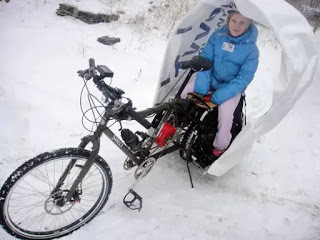 A Do-It-Yourself Snow CanopyRain. I can’t say I’m fond of biking in it, but with proper gear (poncho, rain paints, etc) it’s not so bad. Fenders are essential. Rain canopies on cargo bikes can be had for children. When it rains I also sometimes take the bus, walk (I like walking in the rain) or postpone an errand for another day. If I get wet coming home, it’s no big deal, I just change my clothes. Getting wet on the way to a destination is the biggest issue.
A Do-It-Yourself Snow CanopyRain. I can’t say I’m fond of biking in it, but with proper gear (poncho, rain paints, etc) it’s not so bad. Fenders are essential. Rain canopies on cargo bikes can be had for children. When it rains I also sometimes take the bus, walk (I like walking in the rain) or postpone an errand for another day. If I get wet coming home, it’s no big deal, I just change my clothes. Getting wet on the way to a destination is the biggest issue.Snow. I have a friend in Minneapolis who bikes year round, even in sub-zero temperatures. He gets studded snow tires and says proper clothing is essential. Again, he bikes year around. In Minneapolis. It is more than possible.
Wind. San Francisco is often windy, with wind blowing in from the ocean. My electric bike has increased my happiness level when having to bike into the wind considerably.
 Easy senior mobilitySeniors! Let’s not forget them. They need to exercise for health as much as anyone. E-bikes are wildly popular among those over 65 in the Netherlands, a land where people ride bikes daily from childhood on. Seniors there say e-bikes keeps them on bikes an additional ten years. If you don’t feel comfortable on a two-wheeler, there are always senior electric trikes, very fun, great for shopping and getting around town.
Easy senior mobilitySeniors! Let’s not forget them. They need to exercise for health as much as anyone. E-bikes are wildly popular among those over 65 in the Netherlands, a land where people ride bikes daily from childhood on. Seniors there say e-bikes keeps them on bikes an additional ten years. If you don’t feel comfortable on a two-wheeler, there are always senior electric trikes, very fun, great for shopping and getting around town.Freaking terrible dangerous drivers. In my estimation, two-thirds of drivers are decent, courteous, responsible human beings. The other third are devil's spawn. They speed. They text. They run lights. They turn without looking. Many have no idea where they’re going or lack the mental capacity to negotiate any kind of complex street environment. Some are deeply angry, alienated, unhappy people, and their driving reflects it. Even worse, their vehicles give them a sense of anonymity, power and entitlement, a dangerous combination. Some drivers feel hostile (consciously or subconsciously) towards bicyclists because they perceive bicyclists to have a different social identitythat they view as inferior in status, power and legitimacy. In an effort to enforce and preserve social and personal dominance, they express disdain and aggression towards bicyclists that can be unpleasant if not harrowing. In San Francisco aggressive, reckless drivers hit three people a day on average, often elderly pedestrians in crosswalks, but sometimes cyclists as well.
What about those lawless bicyclists! you might say. Bicyclists aren’t nearly as dangerous. They don’t have the speed or the mass to injure anyone in a car, or even anyone on foot unless they’re going very fast and get a direct hit. It happens, but rarely, mostly because if a cyclist hits a pedestrian with any speed, both are going to end up in the hospital. There are huge consequences to the cyclist. Car drivers hit people every single day. There are almost no consequences to the car drivers.
So with all these crazy, irresponsible drivers, is it just too dangerous to bicycle you might wonder? I’ve been cycling in San Francisco for ten years, and have also during that time bicycled in Seattle, Minneapolis, Nashville, New York, Washington DC, Charleston, Boston, Amsterdam, Copenhagen, Berlin, Vienna and Paris. In that time I’ve had two low-speed crashes, both the result of getting my front tire caught in light rail tracks. (I now have sufficient fear of God of light rail tracks.) Here are some techniques I’ve used:--Use bicycle infrastructure when it exists. (Check bike routes on Google maps.) Good bicycle infrastructure protects bicyclists and substantially reduces conflict between motorists and cyclists. Many communities are slowly putting in bike lanes here and there. Few are protected like they should be and sometimes they just disappear mysteriously, but having a wide enough shoulder to ride on makes a big difference. If you have a completely off road bicycle path that takes you at least close to where you want to go, kick your heels for joy and use it!--Advocate for bicycle infrastructure. The reason you don’t have enough in your community is that not enough people have asked for it with enough urgency.--Advocate for speed humps to slow cars down. Speed kills.--Ride a bike with plenty of lights. I love my Monkey Light. Use lots of lights at night.
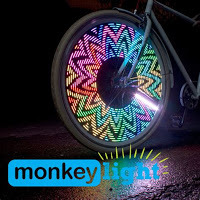 Light up the night!--Wear bright clothing. At night wear reflective clothing. (I break this rule when my husband and I take our e-bikes to the symphony.) Never ride at night without a light front and back. (This rule I don’t break.)--Take residential streets that are calmer with less traffic. The route you would take in a car may very well not be the best route to take by bike.--Don’t be afraid to bike to the right of congested car traffic. Again, it’s speed that kills. Cars going under 20 miles an hour are much less likely to hurt you than cars doing 30 or 40 mph. Even better if they’re crawling along at 5 mph.--Don’t get all duded up in Lycra like you’re training to be Lance Armstrong. Especially if you’re on an electric bike, it just looks silly. Dress like an ordinary human being, doing an ordinary daily task that’s just as important as what anybody in a car is doing. Because it is. Riding an upright bike in regular clothes makes you more visible, but it also makes you less of an alien species to drivers, increasing their empathy and willingness to take adequate safety precautions.--If a car driver pulls some stunt that threatens you, don’t be shy. Yell loudly. Even “Hey, hey, hey!” will do. It’s faster and louder than a bike bell and gets better results.--When stopped at intersections, I do my best to get myself in front of traffic (in the crosswalk if need be, once pedestrians have passed) before the light changes. Better to be in front of cars where drivers can see you than to the right where they might right-hook you as they turn.--At four way stops I signal turns with my hands and make eye contact to make sure the other drivers see me. Often drivers will wave me through before them so it helps to really look at them behind their windshield. If someone is nice to you, give them a friendly wave as acknowledgement.--Watch out for car doors. Take the lane if necessary to get far enough from them so you don’t have to veer suddenly into traffic. If someone opens a car door right as you’re passing it probably won’t kill you but it will likely send you flying and it might break bones. --Watch out especially for people making unprotected left turns. They’re crazed, looking for gaps in traffic, not for you. Wave if you must to make sure they see you.--Safety in numbers. If there are routes popular with other cyclists, then cars drivers are more likely to expect cyclists there and look out for them.
Light up the night!--Wear bright clothing. At night wear reflective clothing. (I break this rule when my husband and I take our e-bikes to the symphony.) Never ride at night without a light front and back. (This rule I don’t break.)--Take residential streets that are calmer with less traffic. The route you would take in a car may very well not be the best route to take by bike.--Don’t be afraid to bike to the right of congested car traffic. Again, it’s speed that kills. Cars going under 20 miles an hour are much less likely to hurt you than cars doing 30 or 40 mph. Even better if they’re crawling along at 5 mph.--Don’t get all duded up in Lycra like you’re training to be Lance Armstrong. Especially if you’re on an electric bike, it just looks silly. Dress like an ordinary human being, doing an ordinary daily task that’s just as important as what anybody in a car is doing. Because it is. Riding an upright bike in regular clothes makes you more visible, but it also makes you less of an alien species to drivers, increasing their empathy and willingness to take adequate safety precautions.--If a car driver pulls some stunt that threatens you, don’t be shy. Yell loudly. Even “Hey, hey, hey!” will do. It’s faster and louder than a bike bell and gets better results.--When stopped at intersections, I do my best to get myself in front of traffic (in the crosswalk if need be, once pedestrians have passed) before the light changes. Better to be in front of cars where drivers can see you than to the right where they might right-hook you as they turn.--At four way stops I signal turns with my hands and make eye contact to make sure the other drivers see me. Often drivers will wave me through before them so it helps to really look at them behind their windshield. If someone is nice to you, give them a friendly wave as acknowledgement.--Watch out for car doors. Take the lane if necessary to get far enough from them so you don’t have to veer suddenly into traffic. If someone opens a car door right as you’re passing it probably won’t kill you but it will likely send you flying and it might break bones. --Watch out especially for people making unprotected left turns. They’re crazed, looking for gaps in traffic, not for you. Wave if you must to make sure they see you.--Safety in numbers. If there are routes popular with other cyclists, then cars drivers are more likely to expect cyclists there and look out for them.
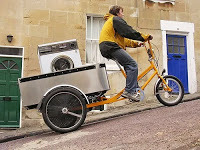 You could do this, too.--Don’t bike too fast. This is key. I rarely bike over 15 mph. I know many cyclists love going faster, but the faster you go, the less time you have to react to cars or other obstacles, and your speed increases the force impact of any spill or collision you might have. Low speed spill onto pavement=skinned knee. Medium speed collision=broken bone. High speed collision=death.--I don’t bike next to 50 mph highways. It just makes me too unhappy. If that’s your only option, I’m really sorry.--Smile. Put out good vibes. Enjoy the trees, the flowers, the sunlight, perhaps a pale moon rising in the east. I find being a middle-aged woman with flowers on her wicker basket also helps.
You could do this, too.--Don’t bike too fast. This is key. I rarely bike over 15 mph. I know many cyclists love going faster, but the faster you go, the less time you have to react to cars or other obstacles, and your speed increases the force impact of any spill or collision you might have. Low speed spill onto pavement=skinned knee. Medium speed collision=broken bone. High speed collision=death.--I don’t bike next to 50 mph highways. It just makes me too unhappy. If that’s your only option, I’m really sorry.--Smile. Put out good vibes. Enjoy the trees, the flowers, the sunlight, perhaps a pale moon rising in the east. I find being a middle-aged woman with flowers on her wicker basket also helps.

